Clipper Titania
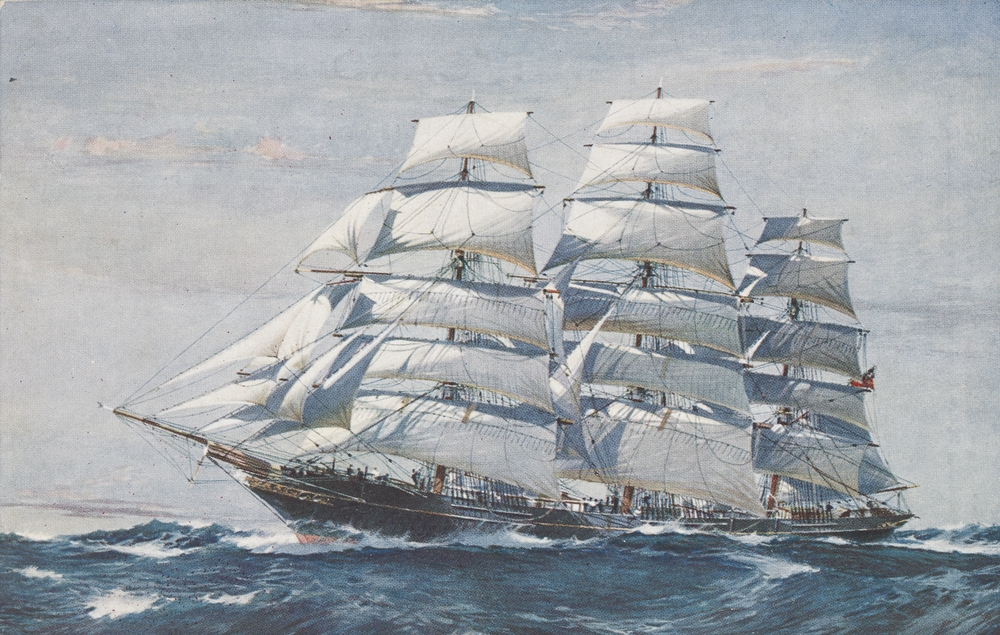
The clipper Titania. A postcard made from a painting by Jack Spurling (c.1930-1945)
( Source: The State Library of Victoria Australia - Item H81.85/147)
The Titania, was a composite hulled "tea clipper" built by by Robert Steele & Co. in Greenock, Scotland in 1866 that had a long and storied career.
Eventually the partnership dissolved and in 1815, and a new company was formed under the name Robert Steele and Company. The new firm was a partnership between Robert Steele and his two sons, James and Robert (II), and continued to operate from the same site.
By 1840's changes in technology and the advent of steam meant that few shipyards were building sail powered vessels, and the Robert Steele yards were no exception. It produced a series of steamers including the SS Beaver, SS Columbia, paddle steamer Liverpool, paddle wheeler Eagle and culminated with the Sardinian to be the last large steamer to be built by Robert Steele and Co.
As technology and ship building advanced in order to accomodate larger and more powerful steamships, it became increasingly more expensive and complicated to produce these steam powered vessels. Technological change had again overtaken the yard as steel replaced iron in hull construction. Steamship construction in general had become more complex, with innovations such as bilge keels to reduce rolling and the introduction of the compound engine. Gradually the skill of the marine engineer became more important than that of the shipbuilder - and Robert Steele and Company was essentially a shipbuilder.
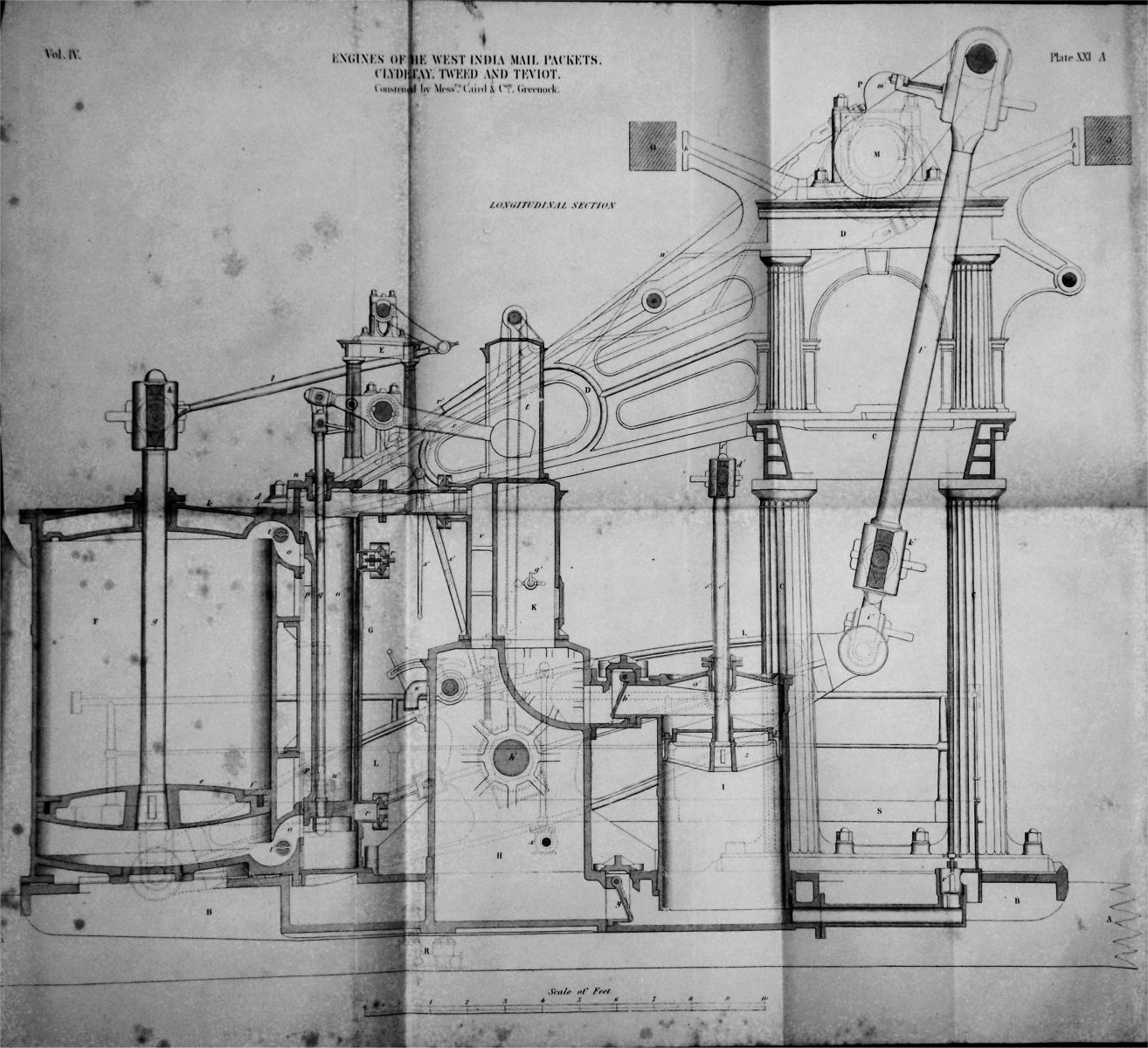
This drawing published in 1845, shows the side-lever engine designed by Caird & Co.
Used in some of Robert Steele's ships, it illustrates
the engineering complexity of building steam powered vessels.
This engine was capable of producing 460 h.p.
(Source: The Practical Mechanic and Engineer's Magazine, 1 June 1845)
In America, there had been a boom in the building of fast, clipper sailing ships that coincided with the San Francisco gold rush in 1849. In a gold rush the prize is often to the first man on the spot, thus ship speed all at once became the desire of the whole world.
In the United States, every clipper was engaged at enormous premiums and every Down East shipyard began to work overtime. From Maine to Maryland, from Baltimore to St. John, N.B., the hammers began going night and day. Even fishing villages, where the launch of a 300- ton ship had been the sign for a general holiday and the cause of much parochial pride and rejoicing, began to build ships of 1000 tons. In some places vessels were actually built in the woods, and hauled to the water's edge by teams of oxen. Farmers turned wood sawyers, and every petty carpenter called himself a shipwright. The ships were mostly built on the share principle; the captain, the ship chandler, the block maker, sail maker and cooper each taking his proportion of shares.
British ship builders were eager to prove that they were worthy competitors to their American counterparts. Before 1850, in Britain, commerce to the British Isles and her colonies was controlled by strong trade monopolies, and government regulations. There was very little competition or a need for fast large ships in regards to long distance voyages.
In 1850, the arrival of the New York clipper, Oriental, in London, sparked a "wake-up call" for the British Mercantile Marine Fleet. She was the first American ship to load directly in China with a cargo of tea direct for Britain, as a result of new trade laws. She proved herself a capable sailor with admirable performance and garnered the highest freight prices in London as a result. It became quickly apparent that in order to stay competitive, the British merchants and ship owners would need faster and better performing vessels than the large, but slow moving East Indiaman known as "tea wagons" which were currently being used in the tea trade.
By the end of 1850, the China tea trade had become an important commerce where speed and larger ships were a necessity. Furthermore, the discovery of gold in 1852 in Australia meant that Britain, which had been locked out of the California gold rush, had in the mercantile fleet a "need for speed" in order to keep pace with America.
Across the pond, in the United States, a financial panic had created a recession in 1857, which was followed by a civil war that caused a marked turndown in the building of sailing vessels. This created an opportunity and boom for British ship builders.
In the late 1850's through to 1870 there was a "renaissance" of sort in ship building in Britain, with a return to the construction of sailing vessels. This was primarily due to the expansion of the long routes of the Australian and Far East trade where fast sailing vessels could still compete with steam. At the same time, new labor-saving devices and changes in sail rigging allowed substantial reductions in the size of sailing crews. The net result was that the cost of building and operating sailing ships fell significantly, which allowed them on certain routes to quite profitable.
As a result, between the late 1850's to 1869, Steele built forty-five sailing ships but not one steam-powered vessel. It is often considered by some that Robert Steele and Company's finest achievements were about twenty clippers built during this period for the China tea trade. The first of which was the Kate Carne, launched in 1855.
These "tea-clippers" were constructed like racing yachts, and many of these beautiful vessels, such as the Serica, Falcon, Ariel, Taeping and the Sir Lancelot, became famous for consistently winning the China Tea race year after year.
No expense was spared to help land the first tea of the season at London and the superior design and construction of the Steele-built tea clippers saw them become the standard by which others were judged:
Though there was no such thing as an ugly tea clipper, Steele was, without a doubt, the designer of the most beautiful little ships that ever floated. Like his modern confrere, Fife, he could not produce an ugly boat. The lines of his vessels never failed to please the eye; their sweetness and beauty satisfied that artistic sense in a sailor, which, though always present, can hardy be described in words.
Suffice it to say that there was not a curve or line or angle in a boat such as the Ariel or Sir Lancelot, which did not carry out the idea of perfect proportion and balance. And it is just this balance in design which gives a ship merit in the eyes of sailors. Steele's gracefully curving cutwaters and neatly rounded sterns fitted each other to perfection. His vessels never gave one the impression, as some boats do, that the bows of a ship had been joined on to the stern of a scow and vice versa. And it was this absolute sweetness to the eye which gave the Steele clippers a look of delicate, almost fragile, beauty, and distinguished them from their rivals.The Clyde clippers, also, were noted for a yacht-like finish : all their woodwork on deck or below was of the finest teak or mahogany, so beautifully fashioned as to bear comparison with the work of a first-class cabinetmaker, whilst bulwark rails, stanchions, skylights, capstans, and binnacles shone with more brass-work than is ever found in a modern yacht.
(Source: The China Clippers, Basil Lubbock, 1914)
The construction details were slightly different between their American counterparts, not only did the British shipyards build smaller clippers, but their vessels were not as heavily sparred. Few British vessels often carried skysails or moonsails, and the result was that they were not often subject to the regular dismasting events that plagued the American clippers.
While the early clippers were made of wood, it was not long before composite construction-wood planking on a iron frame-became standard. Composite construction improved a sailing ship's cargo-capacity, strength and durability; in addition, it was widely-believed that the continued use of timber was essential for the carriage of certain types of cargo, such as tea. Many people connected with sail hoped that these wind-powered vessels might be able to hold their own at least on a few of the long distance trade routes, such as the Australian wool and China tea trade.
As a result of this construction, the British Clippers were vastly lighter and more durable than similarly sized American clippers. The iron frame of the British clippers meant that these clippers could be driven hard and still withstand the pounding of the ocean's waves, and as a result, several of them survived long into the 20th century.
The Titania, was one of these splendid British clippers and was launched on November 26, 1866. At her launchings, she measured in length, 200 feet; breadth, 36 feet; depth, 21 feet; and despite her size only displaced 879 tons. Her framework was iron, but she still had wood planking. Her masts and spars were also made of iron.
The Titania's first commander was the cautious Captain Robert "Bobby" Deas, former master of the ship Ganges. As soon as she was ready for sea she took her departure for China (Shanghai) to compete in the 1867 tea race.
The "Tea Races" as they became known, were very popular in middle of the 19th Century. The clippers carrying cargoes of tea from China to Britain would compete in informal races to be first ship to dock in London with the new crop of each season.
While tea from China had been introduced in the 17th century in Britain, it was generally considered a luxury item, until significant quantities were transported in the 19th century.
In 1834, the British East India's Company monopoly of the tea trade ended, and this opening to competition meant that faster ships were needed, as different merchants tried to be first in the market with each new crop of tea and it became a "free for all" race to port.
The first cargo of tea landed could be very profitable for tea merchants, as they could generally command a higher freight price so they introduced incentives. The first ship to gain a premium was Vision, in 1854, that earned an extra £1 per ton included in her bill of lading, payable if she was the first to dock.
In 1857, the China tea trade made the jump from "shipping intelligence" and commodities section of the business column in local papers to general news, as the public began to take regular interest.
By 1866, newspaper interest in the China "tea races" was at its height, with speculation, updates and detailed reports. Many bets were placed on the outcome of the race, in London, Hong Kong, and the ports of Britain, and by the captains and crews of the vessels involved.
The race was not only a test of sailing, but also of efficient management at the port of departure. Each ship needed to be ready to receive her cargo. The hold was prepared by spreading a layer of clean shingle across the bottom to act as ballast. This was in addition to the iron ballast carried by these extreme clippers. Between 150 and 200 tons of shingle was needed, and it was leveled to follow the curve of the deck above, at a distance precisely measured to be an exact number of tea chests.
The tea arrived in lighters called "chop boats" (taking their name from the identifying marks on each batch of tea they carried). Lower value chests were loaded first as a layer across the ballast, with some shingle being packed between the chests and side of the hold. Then the main cargo was loaded in further layers, being carefully packed in with dunnage by the skilled Chinese dock workers.
To get her correct trim was as important in these sensitive tea clippers as it is in a modern yacht, and half inch one way or the other often made all the difference in a ship's sailing. It was usual to trim about down about 3 feet by the stern, so that when loaded, the ship often drew 4 or 5 inches more water aft than forward.
Sailing a tea clipper presented its own challenges. The nimble, responsive and fleet footed craft could be very fickle, and unforgiving of any mistakes that were made at the helm. The handling of a tea clipper was a ticklish business, and the captain who went into the tea races after being used to slower and less sensitive craft often found himself at sea with a bad mess of it at first.
In the larger slow moving "tea wagon" ships, it was a common practice to put the helm up in a squall, that is to turn tiller to windward to bring the vessel off the wind, running downwind riding out the storm, a technique known as running before the squall
The Naval Text-book and Dictionary for the Use of the Midshipmen of the U.S. Navy in 1862 describes the maneuver as, "... you are stuck with a heavy squall. The first and most important thing to be done, is to get your vessel before the wind, which destroys greatly its force, and becalms many of the sails; and the next is to reduce sail as expeditiously as possible. Put the helm up! Let Fly the main and spanker sheet and outhaul!...you may now run before the squall until it moderates."
But in a clipper ship, this maneuver was considered bad form, although the Board of Trade examiners, and the British Navy still recognized it as acceptable practice.
The danger of putting the helm up in a sensitive and heavily-sparred clipper was this, as the wind freed, the ship gathered more way, and her yards being more fore and aft owing to her long lower masts than those of other ships the sails had a good chance of catching the full weight of the squall abeam. If the ship was the least bit tender, or it was an extra heavy puff, she begin to heel and would put her rail under so far that the helm lost its power over her so it was impossible to bring her before the squall.
Then, in order to gain control of the ship it was necessary to make an attempt to reduce sail and bring her upright. In this case, the halliards would be let fly to drop the sails quickly, but, owing to the angle at which the ship was heeled, the yards would not come down, and stuck like glue onto the masts. This meant that something had to give, and either the ship capsized or more often than not found herself dismasted.
Experienced tea-ship captains invariably gave strict orders to an officer who had just come out of a non-clipper, never to keep away in a squall, but "heave-to" into the wind, luff and shake the squall out of her. However, the officer or helmsman had to be careful not to get his ship aback (back winded), and there was also the danger that the violent luffing could split the sails.
Now, in theory it sounds simple enough to put the helm down (tiller to leeward), and move the ship head on into the wind, into a state known as holding her "in irons".
Yet, anyone who has ever sailed and luffed a yacht or dinghy can appreciate the nerve it takes to bring a 1,000 ton ship into the wind and the let the sails flog about for an indeterminate time. One could only imagine the thundering din and crack of the canvas and it also required the utmost care to keep her from falling off slightly and the yards being taken aback.
Captain Robert "Bobby" Deas, who was the first to take the Titania from the builder's hands was an experienced old sea-dog and a first-class master mariner. He was extremely cautious and a vastly experience commander but definitely not a racing man and had no experience with a tea clipper.
Captain "Bobby" Deas set sail for Shanghai from England on January 12th. He was nearly two weeks out when on January 29th he encountered a fierce gale and storm in latitude 19N off the Cape Verdes Islands.
At around 8 a.m. the Titania was hit by a sudden squall while the man who had been sent up to take in the fore-topgallant stunsail was still aloft. In textbook manner, Deas put the helm up to bring her before the wind.
If Deas had done so in time to get the ship off the wind before the weight of the squall struck her, all would have been well; but he was too late. The squall caught her square on the beam and she went right over until her fairleads were in the water. The topsail yards from the angle of her heel were stuck at the mastheads.
The sailor who had been aloft was fortunate enough to have just scrambled down to the deck before the foremast buckled slightly above the mast coat.
As the mast went over the side it broke again where it smashed in the rail. The Titania's masts were of iron, but for some reason or other the angle irons had been omitted in her case and this was given as the reason why the foremast went. The foremast, maintopmast, mizzen topgallent mast, and all sails spars, rigging, and etc. that were above that had all been carried away. In a just a quick moment the beautiful little vessel was a wreck aloft, but luckily the hull sustained no damage.
All hands were at once called to clear away the wreck and it took the carpenter three whole days cutting through the buckled iron foremast. Saving what he could of the spars, Captain Deas proceeded to rig jury masts and then made the best of his way to Rio de Janeiro for repairs. She was laid up in Rio for several months while a new mast replacement was made of wood. While she was delayed in Rio, her sister ship the Ariel made a record run from Gravesend to Hong Kong in just 79 days. She raised quite a sensation when she arrived in Hong Kong, and when the telegraph was sent home to England of her accomplishment it was hardly believed. Her record still stands today. Captain Keay wrote in his abstracts:
"There were many reports of quicker passages than ours talked of by lovers of the marvelous, but on best authority in Hong Kong there was found to be no foundation for the mythical things said to have been done by some gun-brig or by some clipper. Several naval officers visited us for a look at our chart and track out, also surveyors of long experience in China, and all agreed as to its being the fastest on record by some five or six days in any season, hence very difficult to beat in the N.E. season."
The Titania set sail again for Shanghai in late May, but when she reached the meridian off the Cape of Africa it was discovered that she had fractured her lower main masthead. Sail was at once reduced and the masthead fished, the topgallant mast being sent on deck to relieve the strain upon the cap. She thus had to make the rest of the passage under "easy" canvas and was a long time getting to Shanghai.
On June 29th, in lat. 10° N., long. 110° E., as she was running northward in a storm towards Shanghai the Titania nearly collided with the Ariel who was headed for England with a load of tea from Shanghai. If it had not been for the quick actions of her commander the careers of both the Ariel and the Titania would have been cut short.
Captain Keay of the Ariel notes the incident in his log:
"2 a.m. — Had to keep off for a running ship to avoid collision. Had lost his main-topgallant mast.
Had double topsails and asked us, 'What ship is that ?' I reproved his lubberly conduct in not hauling up to go astern of us and did not have time to answer him. Was it the Titania?"

A sketch of the clipper Titania.
(Source: The China Clippers, Basil Lubbock, 1914
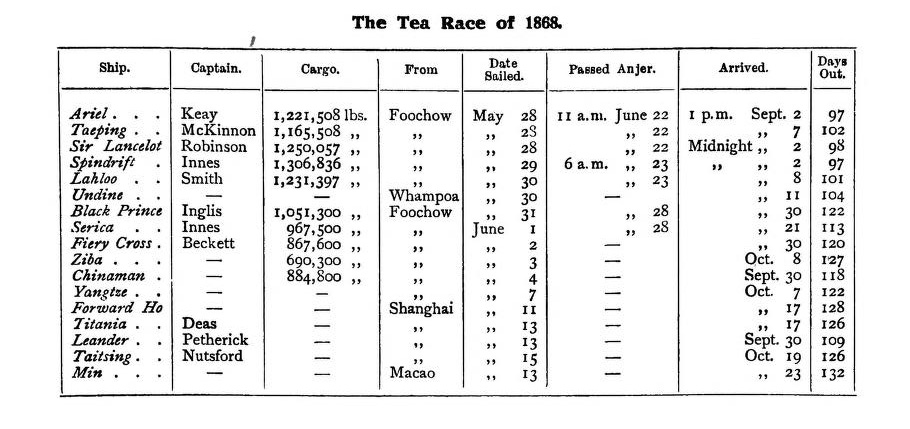
The 1868 Tea Race results, Ariel led the pack,with the Titania finishing with a dismal 126 days out.
(Source: The China Clippers, Basil Lubbock, 1914)
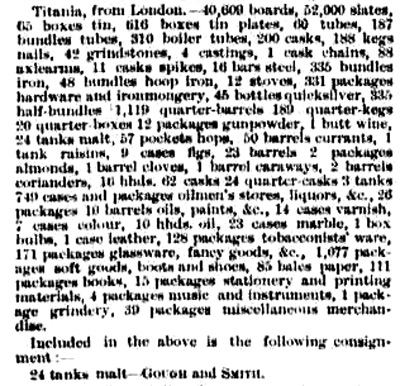
The cargo manifest of Titania published in The Argus shows the 1500 tons of assorted merchandise
she brought from London to Melbourne on January 25 1873
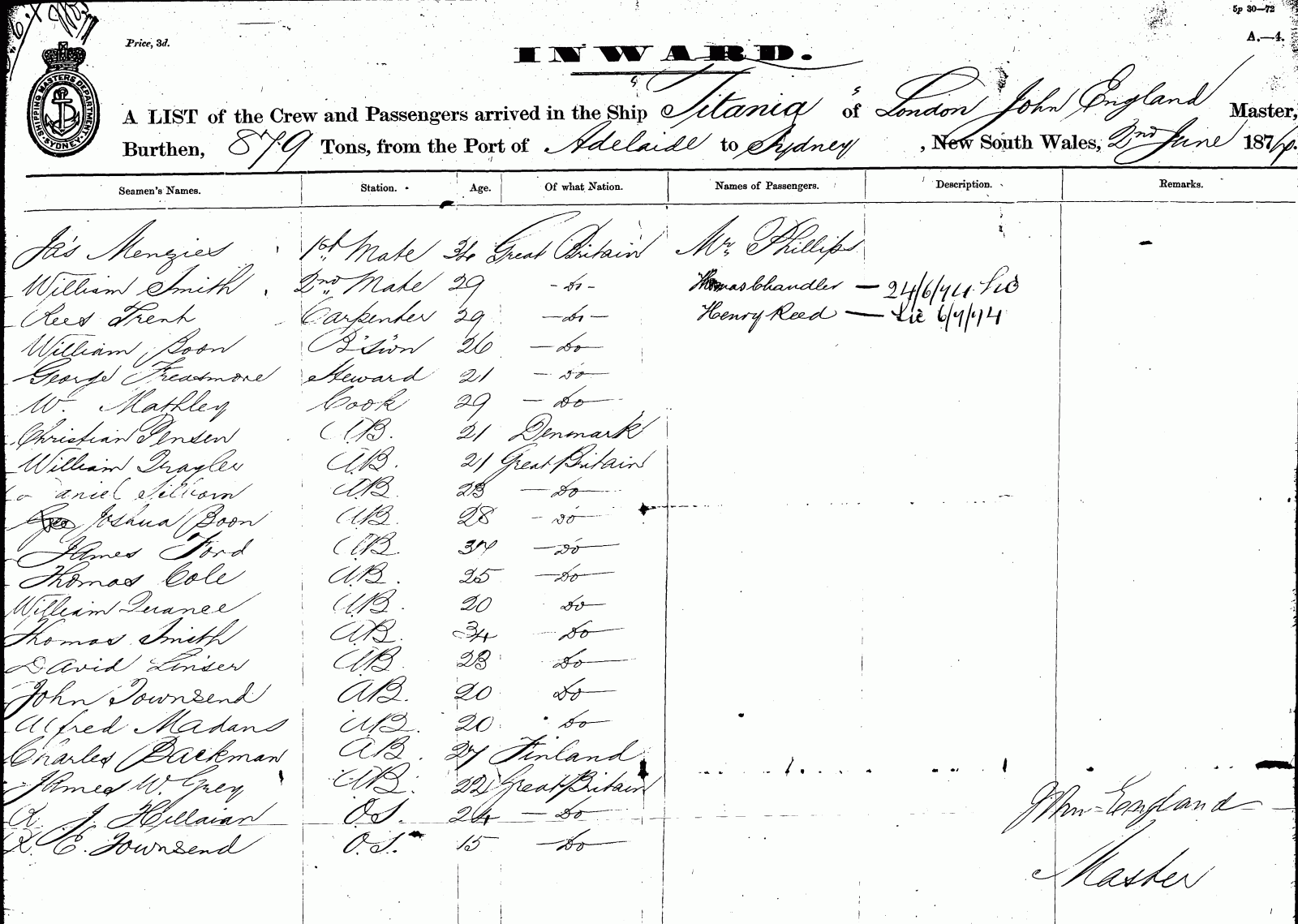
The passenger and crew list of the Titania, 1874.
(Source:State Records Authority of New South Wales: Shipping Master's Office;
Passengers Arriving 1855 - 1922; NGS 13278, [X130-131], reel 430. )
In 1874, about ten clippers were expected in Shanghai that year for the tea crop, including the Thermopylae, Cutty Sark, Sir Lancelot, Norman Court, Forward Ho, Red Riding Hood, Halowe'en and Lammermuir. The damage to the Titania was sufficient to keep her out of the race, and she was held up at Hong Kong for repairs.
The Thermopylae won the day in S.W. Monsoon, completing the voyage in 101 days, and was followed by the Norman Court and Cutty Sark. In the N.E. Monsoon, the Hallowe'en made the run in just 91 days.
The Titania finally left Hong Kong for the return home to London on February 4, 1875 and arrived in May. She then set a course back to Shanghai for tea in June. In 1875, on the run from Shanghai to London, she was beaten by the Hallowe'en in a N.E. Monsoon that had made the trip in just 91 days. The Titania, a fast ship, followed a close second, and completed the voyage in 100 days.
In 1878, the Titania beat the famous Thermopylae in a N.E. Monsoon, completing the trip in 102 days, compared to Thermopylae's 110 days. However, in 1878 tea freights had dropped so much that even the mighty Thermopylae had a hard time filling her holds. The tea trade between England and China that was once so lucrative for the clippers was now over. Instead, the sailing clippers were forced out to longer routes, which were impractical for steamships. By now, most of the clippers were sailing directly between China and Australia, New York or San Francisco.
In 1879 the command of the Titania was succeeded to a young captain, the twenty-seven year old William Townsend from Appledore in Devon, England. He took her again to Australia.
In May, 1879 while the ship was in port in Australia at the Sandridge Pier discharging her cargo, five sailors: William Hallett, Henry Cowen, Tim McNamara, Isane Nyzobin, and Antonio Raynson thought that they could outwit the inexperienced young captain.
The five sailors had in the night, busted through the bulkheads into the coal bunker, and absconded with two cases of brandy. John Wyatt, the chief officer of the Titania, had noticed that all the sailors were all more or less worse for the liquor at about 8 o'clock in the morning, and so he told the captain who reported the incident to the constable on duty at the pier head. Upon investigation, they found in the sailors in their bunks, and fourteen bottles of brandy strewn about the quarters with most of them empty. The value of the cargo was set a £10 and the sailors were sentenced to eight weeks imprisonment and ordered to pay the value of the brandy out of their wages.
However, Captain Townsend's trouble at the Sandridge Pier wasn't just with a bunch of drunken sailors. On May 31, a gale had blown in to the coast, and at Sandridge it reached hurricane force. From the action of the wind and waves, the Titania's hawse pipes were torn out of her and she drifted away from the pier. Fortunately, it was quickly noticed and she was brought back to the dock with little damage, unlike two or three other smaller boats that had met their grief. She then proceeded up the coast to Newcastle, N.S.W. in ballast for coal.
On July 2nd, 1879 the Titania left Newscastle, N.S.W. with 1082 tons of Coal for Manila, and arrived on August 18th, with a passage of 47 days, beating out the Nyassa that made the run in 50 days. Her old rival Oberon made the run from Sydney in just 35 days. In that year, the Norman Court, made for Hong Kong.
The Titania arrived back in England from Manila in mid February.
On April 29th, 1880 while the Titania was in London, Captain William Townsend, the dashing twenty-eight year old sea captain married a young twenty-one year old women from Essex, named Matilda Gertrude Deas, who was a relative of Captain Robert Deas, the first captain of the Titania.
While Captain Townsend was getting married, two other ships of the same name were making headlines that are often confused with the clipper. The first one is a small brig, Titania.
On July 7th, the brig, Titania under the command of Captain Lloyd was outward bound from St. John's, Newfoundland in ballast for Miramichi, when 50 miles southeast of Cape Spear, when at about 12:30 am in a dense fog, she hit an iceberg. On going below it was found that the iceberg had punched a gaping hole in her bow and the water was pouring in fast. The captain gave the command to abandon ship, and the crews were all put into lifeboats with provisions and personal effects. The boats drifted nearby and they watched the Titania slowly sink. One of the crew, John Rees, a part owner and first mate had brought with him to the large sum of money and possessions which it is said he placed in the aft of the boat.
What happens next is a matter of controversy, but the Captain reported in the Evening Telegram (St. Johns N.L. 07-08-1880):
The boats had remained close by while the captain and the crew watched the small brigantine slowly settle down. Just before the water reached the hatches, the mate who was also part owner, John Rees had apparently forgotten something of great significance aboard the Titania and insisted on being taken back to the sinking ship. At the time, no great objection was offered and he was placed on board to retrieve the missing articles. As soon as he reached the deck, however, it was said that he declared with great determination to go down with the ship. Despite the entreaties of the captain, who was backed by the prayers and tears of the crew (his own nephew included) could shake his purpose. There he stood calmly and resolved to sink with his property. He had not long to wait. Soon the water washed over the decks and the Titania plunged forward and disappeared beneath the waves, the mate not making the slightest effort to save himself. Slowly and sadly the shipwrecked men turned their eyes from the spot, and tried to forget the heart-sickening sight they had just witnessed.
It was said that the sea was tranquil and the small brigantine floated for nearly three hours before sinking. When questioned why the Captain had not made an effort to save the mate, he reported that, "...he was a very powerful man, and he feared to board the ship lest he fling him overboard." It was reported that the accounts of the sinking varied from crewman to crewman and no two stories seemed to collaborate the event, leading to some speculation that the mate met with foul play.
Ironically, 32 years later the famous ocean liner Titanic, met a strikingly similar fate.
The second ship making headlines was the S.S. Titania, an iron screw steamship belonging to the Port of Liverpool, of 1,961 tons gross and 1,273 tons net register, and fitted with engines of 170 horse power. She was built and launched at Middlesbrough in the year 1880 with much fanfare and planned to began regular trips to New York for the Red Cross Funnel Line. On her maiden voyage from Durham, the Titania in a dense fog, collided with a small fishing coble. It capsized and four men were tossed into the water. Unfortunately, a young man named Robert Taylor, just nineteen years of age was drowned.
The collision substantially damaged the steamer Titania and she needed to put into Liverpool for repairs for several months before sailing for New York. In November, she fell into a strong S.E. gale which strengthened into a hurricane. A few hours into the hurricane, the spare propeller in the 'tween decks had broken lose from the ringbolts and was violently hurled about, along with much of the cargo. The action cause the propeller to punch holes in both sides of the ship, and she began to take on water. In the morning, the Titania found herself in critical state, some of the deck work was broken, all the stores completely destroyed, and two men were injured while jettisoning the cargo. The holes on the starboard side of the steamer were level with the sea. There were also several smaller holes in the port side, and the cargo, which was in bales, got adrift, had settled in a crushed mass on the starboard side. The Bel Air, coming upon the Titania hove in sight and an attempt was made to lower the boats from the latter vessel, but in the rough seas they were smashed against the side. Seeing that no communication could be established by this means, the mate of the Titania plunged into the sea and boldly struck out for the other steamer, and succeeded in gaining the deck of the Bel Air. After making arrangements for the Bel Air to tow the Titania into port, he again plunged into the ocean and swam back to the Titania. The Titania was towed into Halifax where she was repaired and put back into service. Only two years later, in 1882, the steamship Titania overloaded with cattle was lost in storm five days out from New York. There was only one survivor.
Soon after his marriage Captain Townsend's new bride accompanied him aboard the Titania to the sail to the far east.
At the time, coal from South Wales was regarded as the best steaming coal in the world. It burned brighter and lasted longer, making it the most economical coal for shipping and industry. Welsh coal was sent all around the trade routes of the oceans with hundreds of coal bunkering depots and shipping agents set up in the remotest corners of the globe. In June, 1880 like other notable ships, the Titania loaded her hold with Welsh coal from Cardiff, and was destined for the South East Pacific to unload at Manila and then sail to Foochow for tea and then back to Liverpool.
Only a few days out, the Titania met up with her old rival, the Cutty Sark. A journal kept by Charles Arthur Sankey, on board the Cutty Sark, describes the event:
However, we got a fair start with a leading wind down to Cape Finisterre where we picked up the northeast trades, then squaring away the yards we made a run for the Line. Studding sails and every rag of canvas that could be stuck on was ordered set, for we had a record to keep up and another old antagonist. The clipper Titania in company with us was bound also for Anjer. We were brought very close together and so we sailed for nearly four days when we drew apart with a challenge for a race to Sunda straits.
...We headed down the south Atlantic close hauled, making a southwesterly course to latitude 40 degrees south, where we picked up the west wind that forever blows round the southern seas. There is a legend that these seas are inhabited by a race of small people who delight in taking free rides on ships and can raise a real blow for their special favourites. Certainly they must have known we were coming! It was a grand experience showing what a ship like the Cutty Sark could do when driven by a captain like ours. Yes, it was cracking on sail all the time!
As usual at such times, in spite of all the squabbles between officers and men everyone seemed keen to make the best of the run and enjoy the excitement. My old knowledge of yacht sailing came in handy and I was counted one of the lucky four Captain Wallace allowed to steer. The first mate demurred at my being at the wheel single-handed at such a time, but I was left on the job, much to my great delight and dong my prettiest. It was no small thing either, as one has to have lots of nerve when a great stern sea comes whizzing up with part of the top coming over the rail and lifting you waist high as the ship rose in grand style and stepped out at her best.
Now the wind began to come out of the southwest in heavier and heavier squalls and our top gallant sails and chain sheets got a heavy mauling. The men were sent aloft to bend a new lower fore topsail which they swayed aloft to "Blow! Boys! Blow!"
With a gallant ship and a bully crew:
Blow, boys, blow!
We're just the boys to pull her through,
Blow, boys, blow!
For up aloft this sail must go
Blow, boys, blow!Up went the topsail in its stops, the men heartened by the chanty, but it was another thing to bend it. For two hours the men fought aloft, sweating and swearing, the foot rope swinging and dipping as they braced against the tilting yard. It seemed an impossible task but set it must be and eventually was as our gallant little ship cleared herself of a green sea which rushed over the stern and swept the length of the deck. During the whole of this strenuous time our little clipper steered beautifully and our entire crew played up most gallantly, wishing only to give the ship the best chance to break the record. It was stand by the whole time, and eat and snooze when we could.
Soon after this event I heard from the second mate that, there was some anxiety on account of a variation between our two chronometers and their rating. They had apparently got apart about five minutes of time or seventy miles in longitude. Unlike the Fantasies, we used to hear all about the navigation from Captain Wallace. He expected two of our berth to take sights for latitude and longitude on Sundays and then he would invite us down for dinner in his cabin with the officers.
...Arriving off the islands of Sumatra and Java the error in chronometers succeeded in fooling us badly. For though it does not matter being a bit out of position when there is lots of sea room, it does not do to run chances of going on the rocks. So we kept well away from the entrance of the straits until we had attained the latitude, then went running due east for Java Head.
Through the portals of these straits the fleets of sailing ships to and from China have made their way for many years. Situated almost on the Line, the southeast trade winds are broken up at its entrance, and dependence has to be put in every favourable slant of breeze or squall. While no high seas are met, it takes the highest class of seamanship to navigate from this point to various destination in the China Seas and eastern Pacific ocean.
We were very unfortunate in making the landfall. The fresh wind that we were carrying and which should have lifted us up the Straits died away just as we made the entrance. Strange to say, our antagonist, Titania, just managed to take advantage of the same wind. The result was, that while we lay becalmed off Krakatoa Island, she was passing through. Had our chronometers been correct we would have either won the race or at least sailed up the Straits together.
On August 18th, Titania departed Manila for Foochow, but only just a day of port she out encountered a violent typhoon that "...according to the estimate of the Director of the Observatory of Manila, the force of wind reached sometimes the velocity of 100 miles per hour, though an exact account cannot be given, owing to the destruction by the wind of the two anemometers possessed by the Observatory. The Lighthouse at St Nicholas has disappeared altogether and 11 lives were lost."
The China Mail reported, "A destructive whirlwind (a tornado or a secondary whirlwind accompanying the Typhoon) was reported to have occurred in the village of Polo, near Bulacan (some 20 miles north of Manila) on the afternoon of the 19th, causing great destruction to a place named Mabolo. Nearly the whole of the houses of light construction were razed to the ground and two of stone suffered a like fate: but no loss of life was reported. This phenomenon was also reported to have crossed the parish of Pineda, where it caused a great noise, it carried away one man, one woman and one bullock; the last named, on being found, had one of his horns knocked off. One house disappeared under the force of the tornado."
There was a great amount of destruction of small craft, Captain Townsend and the Titania found herself tossed up and stranded on the sandy shore of the Malecón, in Manila. Another ship, the Masonic it is said, went ashore in Cavite, where she had been anchored for some time. On shore the destruction was also great, especially to houses of light construction.

The Malecon in Manila, Philippines c.1900, the Titania was forced onto the shore by a hurricane.
After making repairs, the Titania against set out into the Straits of Sunda, and was once again hit with another series of punishing typhoons and gales was reported to be dismasted for the third time while in the Straits of Sunda. Captain Townsend managed to get word to Haiphan and his predicament was reported in the China Mail in Hong Kong, on November 4, 1880. After making repairs she departed Hong Kong on November 22nd, and finally made Foochow at the end of December. She arrived back in Liverpool, England in early March, 1881.
The Titania then began a series of runs to Melbourne carrying general merchandise. On July 29, 1882 she arrived off Cape Moreton, making the run from Liverpool in just eighty-seven days. On Monday, December 11th, in celebration of Separation Day, which commemerated a proclamation made in 1859 in which the land which forms the present-day State of Queensland was removed from the Colony of New South Wales and created as a separate Colony of Queensland. To celebrate, the Monday afterwards was declared and banking holiday and Brisbane held it's annual regatta. On this occasion, Titania became the flagship for the Brisbane Regatta and was moored in the Government Domain across from the Dry Docks. The clipper was opened to the public which were ferried across in boats from the wharves. The price of admission to the Titania was 3s for Gentlemen and 2s for Ladies.

An ad for the Brisbane Regatta,
(Source: Brisbane Courier, Friday 8 December 1882)
At the beginning of 1883, she arrived at Lyttleton, N.Z. in ballast, and waited for her sailing orders. On March 10th, she finally sailed for Falmouth and Cork with 10,364 sacks of flour quick on the heels of two other clippers, the Centurion and the Dallam Tower, each captain boasting that their ship was the quickest of the fleet.

The Titania again made the local newspaper headlines in a race
back to England with with two other clippers.
(Source: Otago Witness, 17 March 1883)
She made the run in 86 days, and arrived in London on June 4th, 1883. She then went to Cardiff, and loaded with coal, and departed again for Manila on July 30th, 1883. The Titania then continued to Hong Kong and then back to London, in a familiar pattern of trade with Java.
Meanwhile, throughout the 1870s and 1880s France expanded a colonial campaign that had started in 1858 with an aim to colonize the coasts of Tonkin. The French government had hoped that through negotiation and peaceful colonization they could secure a profitable trade route with China that could bypass the treaty ports of the Chinese coastal provinces and gain privileges for the Roman Catholic Church.
Things began to escalate in 1881, when French Commandant Henri Rivière was sent with a small military force to Hanoi to investigate Vietnamese complaints against the activities of French merchants. The Vietnamese had complained that they were being exploited and ill treated by the French Colonialists.
In defiance of the instructions of his superiors, Rivière stormed the citadel of Hanoi on 25 April 1882. Although Rivière subsequently returned the citadel to Vietnamese control, his recourse to force provoked alarm both in Vietnam and in China. The Vietnamese government, unable to confront Rivière with its own ramshackle army, enlisted the help of Liu Yongfu, a chinese soldier of fortune, a commander of a large mercenary army whose well-trained and seasoned Black Flag soldiers would prove a thorn in the side of the French. The Vietnamese also bid for Chinese support. Vietnam had long been a vassal state of China, and China agreed to arm and support the Black Flags, and to covertly oppose French operations in Tonkin
In May, the Black Flags challenged the French to an all out confrontation, which became known as the Battle of Paper Bridge. Rivière and the French troops were defeated. Rivière himself was killed, which sparked outrage in France, and the government vowed to avenge his death.
In August 1883, negotiations between France and China began to break down over the region, when France attacked a series of forts along the Tonkin coast, in an attempt to control North Vietnam from the Chinese. As a result, the Chinese helped bolster the ranks In a series of back and forth battles with the Vietnamese, the French asked China to remove their military support of the Vietnamese. It became an uneasy time for the all colonists in China, as anti-foreign sentiment spread throughout Southeast Asia.
.jpg)
European residents walk warily in the streets of Guangzhou, autumn 1883.
The tensions eventually culminated in a large naval battle between the French and the Chinese Navy at Foochow August 22, 1884. The battle, a two-hour engagement was watched with professional interest by neutral British and American vessels (the battle was one of the first occasions on which the spar torpedo was successfully deployed), Courbet's Far East Squadron annihilated China's outclassed Fujian fleet and severely damaged the Foochow Navy Yard (which, ironically, had been built under the direction of the French administrator Prosper Giquel).
Nine Chinese ships were sunk in less than an hour, including the corvette Yangwu, the flagship of the Fujian fleet. Chinese losses may have amounted to 3,000 dead, while French losses were minimal. Courbet then successfully withdrew down the Min River to the open sea, destroying several Chinese shore batteries from behind as he took the French squadron through the Min'an and Jinpai passes.
.jpg)
Battle of Foochow (Fuzhou) occurred on August 22nd, 1884
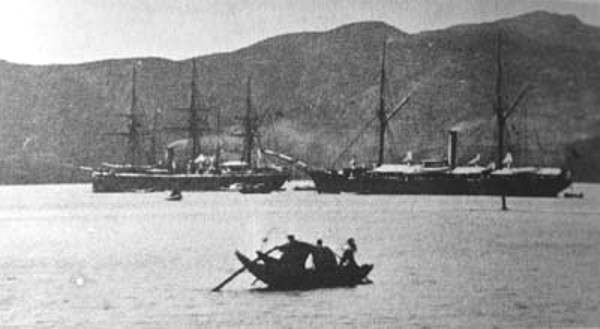
The Chinese flagship Yangwu and the gunboat Fuxing at anchor off the
Foochow Navy Yard on the eve of the battle.
The French attack at Foochow (Fuzhou) effectively ended diplomatic contacts between France and China. Although neither country declared war, the dispute would now be settled on the battlefield. The news of the destruction of the Fujian fleet was greeted by an outbreak of patriotic fervour in China, marred by attacks on foreigners and foreign property. There was considerable sympathy for China in Europe, and the Chinese were able to hire a number of British, German and American army and navy officers as advisers.
Patriotic indignation spread to the British colony of Hong Kong. In September 1884 dock workers in Hong Kong refused to repair the French ironclad La Galissonnière, which had suffered shell damage in the August naval engagements. The strike collapsed at the end of September, but the dock workers were prevented from resuming their business by other groups of Chinese workers, including longshoremen, sedan chair carriers and rickshawmen. An attempt by the British authorities to protect the dock workers against harassment resulted in serious rioting on 3 October, during which at least one rioter was shot dead and several Sikh constables were injured. The British suspected, with good reason, that the disturbances had been fomented by the Chinese authorities in Guangdong province.
The strike and unrest in the ports of Hong Kong, and Foochow, made it unprofitable and risky for the Titania on her Java routes. By now, most of the profitable Australian routes were being serviced by faster screw-driven steamships, or larger Down-east built clippers with much larger cargo capacity, and the trade in the Orient for the moment was at a standstill.
In December, 1885 John Henry Busby of Shaw, Bushby & Co. sold the Titania to the Hudson Bay Company in favour of building and purchasing more steamships.
The command of Titania was placed into the hands of Captain James Lawrence Dunn, who at age 54 was an experienced captain that had previously commanded a series of clippers owned by Shaw, Maxton & Co., the original owners and builders of the Falcon, Oberon, Ariel, and Titania.
James L. Dunn, a respected crack clipper captain was very familiar with Robert Steele's Greenock built clippers. He first took over command of the Falcon from Captain Keay in 1865 and was in charge of her until 1874. The Falcon, a sister ship to the Titania, was one the earliest and certainly a fast tea clipper. Captain Keay, who commanded both the Ariel and Falcon in turn, was of the opinion that Ariel was always one knot faster all round than the Falcon.

During his career, Captain James Dunn commanded the Falcon from 1865-1874
(Source: Clippers in the China Trade... the Falcon.... and other clippers on the China Coast
Item -PAF7712 National Maritime Museum, Greenwich)
In 1875, Dunn was entrusted with the command of the Oberon from Keay formerly from the Ariel who had now been transferred from the Oberon to take command of a large steamship, the Glenartney. The Oberon was also a sister ship to the Titania, but with one major difference, she had originally been equipped with a steam powered screw engine. Her engines proved to be more of a liability than an asset, as without them she was a better sailor. By the time Dunn took command, the engine had been removed in favour of her sailing abilities. In 1880 he took command of another well-known clipper Norman Court for her tenth and eleventh voyages.
Dunn was very proud of the workmanship and beauty that the British tea clippers offered. In every port he visited, he often opened his ship to the public viewing and was willing to give anyone who asked a tour. When he sailed the Oberon into San Francisco for the first time in 1876, he invited members of the press aboard the ship. The press reported the cabins were neat and tidy, and they sailors were afforded good treatment, and after viewing the ship they remarked, "Taken all In all she may be called a model ship, and with fair play should last for centuries. With 'success to Captain Dunn and his noble vessel,' we bid him adieu on his voyage to Liverpool with our 'golden grain'."

The Titania's sister ship Oberon under the command
of Captain James Dunn arrives in San Francisco
(Source: Daily Alta California, 8 October 1876)
Captain Dunn was a neat and tidy commander whose signature trademark was taking an immense amount of pride in keeping clippers under his command in bristol condition. In one instance, Captain Stainton Clarke, whilst serving as an officer on board the Edinburgh Castle, was sent aboard the Titania one evening with a message for Captain Dunn.
As soon as Clarke had delivered himself of his message, Captain Dunn asked, "Is this the first time you have been aboard the Titania ?"
"Yes, sir," replied young Clarke.
Upon which Capt. Dunn called out impressively to his first officer, " Mister, take a lamp and show Mr. Clarke over the ship."
Not to be neglected, his men were treated with respect and dignity. Captain Dunn was known for his lavender coloured gloves and his penchant for frock coats. His crisp attire and fashion sense earned him the nickname, "Dandy" and he was often referred by his crew and those that knew him along the waterfront as "Dandy Dunn".
Captain James Dunn was married to Susan Inglis who came from a long line of ship owners and captains. Her uncle was captain William Inglis who was part owner and commander of the Black Prince.
While Dunn was commanding clipper ships out of England, on the west coast of the Dominion of Canada, Port Moody, a small town in Burrard Inlet had been selected as the western terminus for the railroad. The town of Port Moody instantly boomed when the Canadian Pacific Railway (CPR) announced they had selected the town as the western terminus in the late 1800s. Lumber was in demand for wharves, round houses, bunkhouses, storehouses as well as millions of railway ties, bridges, and trestles. The Hudson's Bay Company planned on capitalizing on the growth of Port Moody and the Vancouver area, and the fast Titania was a good candidate for bringing merchandise and supplies. In 1885, A British company, Head, Wrightson and Company had been contracted by the government to produce the pilings for the railway wharf and they needed to be transported to Port Moody in a hurry.
On January 11th 1886, Captain Dunn sailed the Titania from Liverpool to Victoria under the ownership of the Hudson's Bay Company. She was carrying general cargo, supplies, and the pilings for the western terminus of the C.P.R. Railroad at Port Moody.
The Titania was sighted off Start Point, off Devon on January 23, 1886 and arrived in Victoria, B.C. on May 1st, a total run of 109 days.

The lighthouse at Start Point, Devon. The Titania began
her first trip for the H.B.C. company to Victoria on Jan 11th, 1886.
She arrived in Victoria on May 1st, 1886, a run of 109 days.

"Clippers off Start Point at Sundown"
Painting by Roger Charles Desoutter (b.1923)
The run set a new record, and the Titania made local headlines in the May 07, 1886 Daily Colonist in an article entitled,"The Ship That Lowered The Sailing Record From London To Vancouver Island".
...When the captain was congratulated, he remarked, "The truth is we never had a fair day's run during the whole trip, though sometimes for a few hours we were able to make 14 or 14 1/2 knots an hour. If we had had the southwest trades we should have made the run out in ninety-five days." Rate of Speed, "Well, Captain, we notice that the ship Ragna lays claim to a faster pair of heels than your tight little craft; and explains that if she hadn't been light and made more leeway than you did, she would have left you in her wake!"
"Look here," said Capt. Dunn, "I can answer that in a few words: If they're so fast why don't they do the work? We came from London -- loaded -- and everything we saw gradually kept going further astern -- got small by degrees and beautifully less. Here's an example," he continued, turning to the log and reading an extract: 'Wind light, from the north-west, --sea calm-- saw lots of turtle -- caught three of them -- sighted a bark in ballast to windward,' the next day 'sighted bark to leeward, long way off." and next day 'sighted bark a very long way off.' and so on with all of them we met, "it's very certain that if we didn't creep ahead the vessels we passed must have drifted astern; and I say again, if they're are so fast why don't they do the work! Let them get cargoes like the vessel on whose deck we are standing; a neater and smarter little clipper than she is I am proud to say none could wish to command." The spick and span appearance of the vessel's holy stoned decks, shining brasswork, cleanly scuppers, spotless paint work, her taut standing rigging, and the trim appearance of her running gear, evinced the good grounds for the remark.
Under the command of Captain Dunn, the Titania had gained a reputation as, "the smartest ship in the Pacific", which caused some jealousy and heart burning among rival ships. Indeed, although the great tea races were over, each captain was still vying to be known as the smartest and fastest ship to a port. The Titania on that run, had been challenged by the Ragna, whose pilot claimed that she was beaten by the Titania only ten miles into Race rocks by the famous clipper.
Captain Dunn addressed the "Pilot" in a letter to the editor in the May 08, 1886 Daily Colonist:
In your valuable issue I read this morning a letter signed "Pilot," which from the errors contained therein calls for an answer. On the 13th April my position was 8 deg. north. 118 deg. west, so Ragna could hardly have seen me 8 degree distant. I past Race light at 3 a.m. May 1st. Ragna had not arrived in Royal Roads at sunset the same day. As the name "smartest sailer on the Pacific " seems to cause much heartburning let me assure "Pilot" and others that it was not applied by me to the Titania. I simply did my best to bring the fine ship to which I was appointed safely and as quickly as possible to her destination.
In conclusion, I would ask "Pilot" to apply his powerful mind for the benefit of strangers like myself who after bringing their ships from a long and arduous passage and arriving off the dangerous Race rocks look for local experience to assist them on the last and not least dangerous part of their voyage. At good and broad daylight on the 1st May the Race rocks aleam, having the jack flying, I looked anxiously, but in vain, for the wished for pilot. I passed about three miles out and stood for Albert Head to best of my ability, but the wind failing I had to make sail to hold my own, and as a matter of fact did not get a pilot till near Albert Head at 7 a.m., who then took me in safely to Esquimalt harbor.
Trusting this subject may now die out, I am, sir, your obedient servant,
James L. Dunn
Indeed, the Titania's cargo not only contained general merchandise bound for Victoria, but it also was transporting time sensitive and politically charged material for a new railroad pier. After discharging general merchandise and cargo in Victoria, the Titania was towed by the tug Pilot to Port Moody to deliver iron pilings for the new railroad terminus, on May 23, 1886.
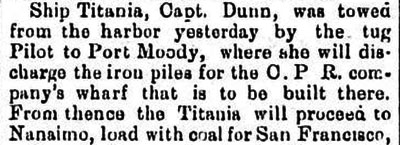
(Source: Daily Colonist, 05-22-1866)

The steam tug Pilot off the Victoria waterfront; Marine Hospital in the background. c.1895
(Courtesy: BC Archives Item - A-00108). The tug Pilot towed the Titania to Port Moody in 1886.
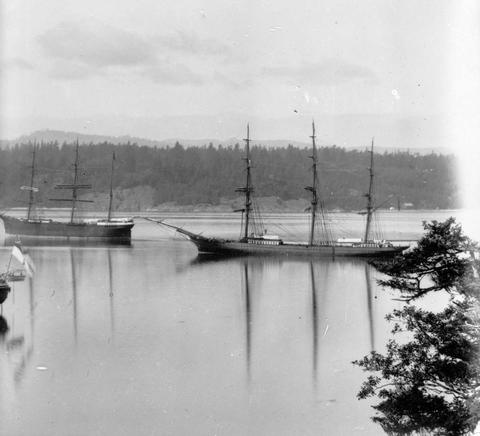
The British Tea Clipper Titania off Victoria Harbor circa 1890.
This pictures shows a great comparison of her sleek and rakish lines
compared to the Downeast Clipper anchored beside her.
(Courtesy: BC Archives item - D-01298)
Port Moody had been chosen as the original Western terminus for the C.P.R. in 1879, and construction of a station had been complete in 1882.

Port Moody was chosen as the original site for the Western Terminus for
the CPR railroad (C.1885)

The new station at Port Moody built in 1882.
Iron pilings were shipped to Port Moody in 1886 by the Titania.
(Source: Port Moody Station Museum - Glenbow Archives # na-4140-85)
However, although Port Moody had been designated in the charter by the federal Government as the nearest port on a navigatible waterway, it had some drawbacks: it was nearly 12 nautical miles (22KMS) from the entrance of the First Narrows on English Bay, and a steep hill ran up from the edge of the water that left little room for townsite development. In addition, the tide in the area varied as much as 4.2 meters, and due to the terrain the port was enveloped in fog most of the time.
Consequently, in 1884, the CPR sent a high ranking official to determine if Port Moody would actually be suitable for a western terminus. He reported back to high ranking officials with a glum secret: the eastern end of Burrard Inlet was too shallow for the ocean-going ships that were part of the railway's global shipping plans. In August, 1884 the dynamic and forceful William Van Horne, general manager of the CPR railway, visited the Granville townsite. A little more than a month later, he asked CPR directors to choose it as the line's western terminus, instead of Port Moody. They agreed, and the Canadian Pacific Railway (CPR) secretly negotiated with the provincial government for valuable land on Coal Harbour between the old Bricklayers claim and the townsite of Granville.
In order to seal the CPR terminus deal at Vancouver, the provincial government granted the CPR a total of 6,280 acres, which included the original downtown (Government Reserve) area and a vast area south of False Creek, thereby laying the foundation for a real city. It also meant that Vancouver would become a CPR-dominated town that looked both into the interior and out to sea.
Despite the negotiations, the CPR and the Government went ahead with the building of the wharf and terminus at Port Moody, and it was completed in June of 1886, and the first train arrived there at high noon from Montreal on July 4th, 1886. This train consisted of Engine #371 two baggage cars, a mail car, one second-class coach, two immigrant sleepers, two first-class coaches, two sleeping cars, and a diner.

The first C.P.R. train arrived from Montreal, on July 4th, 1886.
Port Moody was short-lived as the western terminus.

The first train #371 arrives at the Port Moody seaboard in 1886.
While the wharf and terminus was under construction in Port Moody, to achieve legal status as a city, on January 8, 1886 the villagers at the Granville Townsite appointed a committee to draft and circulate a petition that was then moved through the legislation stages and became a private member’s bill in the British Columbia legislature. At Van Horne's suggestion, the townsite of Granville was renamed, "Vancouver" and the City of Vancouver was created under the Vancouver Incorporation Act of April 6, 1886. One month after the incorporation, 499 voters elected a mayor and 10 aldermen. The infant city included the old Bricklayers’ Claim, the downtown CPR land grant, the townsite of Granville, and CPR land across False Creek up to 16th Avenue.
Indeed, the arrival of the pilings at Port Moody and where the final terminus should be built became quite a contention in the Federal parliament, and at a meeting in Ottawa on May 31st, 1886 the matter of the pilings was debated. The point questioned was why the material was brought all the way from England on the Titania, when it could have been produced locally. In some circles the building of the railway and the debacle surrounding the final terminus is referred to as "The Pacific Scandal". In order to facilitate the quicker and rushed building of the wharf, it was built using wood pilings instead of the iron ones that had been brought from England which remained in a heap and were actually not used in Port Moody. In 1887, they were later moved to Vancouver for construction of the wharf there.
An old time pioneer, Dr. H.E. Langis in January, 1932 recalls seeing the pilings lying at the Moody wharf:
"The government built the C.P.R., and they sent iron piles to build the wharf all the way from England, around the horn. The piles were lying on the Port Moody wharf in heaps; some may be there yet. The hotel in Fort William and the Port Moody wharf were items in the Pacific scandal; enormous waste of money; cost Sir John A. Macdonald defeat; McKenzie beat him.." (Source: Early Vancouver Volume One By: Major J.S. Matthews, V.D. Pub. 1932)
The contract was made between Head, Wrightson and Company in Stockton on Tees, England and the Government for the pilings in 1885.
OTTAWA, 10th March, 1885.
ARTICLES OF AGREEMENT entered into this day of seventeenth of June, in the year of our Lord one thousand eight hundred and eighty-five, and made in duplicate between Messrs. Head, Wrightson and Company, on Stockton-on-Tees, London, England, owners of the Teesdale Iron Works (hereinafter called the contractors), of the first part, and Her Majesty Queen Victoria, represented herein by the Honorable the Minister of Railways and Canals for the Dominion of Canada (herein after called the Minister), of the second part, WITNESSETH, that the contractors, for and in consideration of the conditions and agreements hereinafter mentioned, doth hereby agree to and with Her Majesty, her successors and assign, to manufacture, supply and deliver to the satisfaction of the said Minister, in full and perfect accord ance with the terms and agreeably to the true intent and meaning of the specifica tion hereunto annexed, marked "A" (which is hereby agreed and declared to be part and parcel of this agreement and to be taken and read as incorporated here with), and which is hereinafter called the specification, two hundred and twelve iron piles, with caps and points; the said delivery of the same to be made by the con tractors on the Canadian Pacific Railway wharf at Port Moody, Burrard Inlet, in the Province of British Columbia, in bond and free of all charges except customs duty, on or before the twentieth day of September, A. D. one thousand eight hundred and eighty- five; the said piles, caps and points being required for the said Port Moody wharf.
In consideration whereof Her Majesty's Minister doth hereby agree to pay the contractors the sum of twelve pounds nine shillings sterling for each ton of the said iron piles, caps and points hereinbefore mentioned (the ton weight for the purposes hereof being fixed at two thousand two hundred and forty pounds) the whole being payable as follows, that is to say : — the price of each shipment to be paid to the contractors on account of the same through the financial agent of the Government of Canada, or other duly authorized agent or banking house in British Columbia, on delivery thereof on the wharf at Port Moody as aforesaid, free of all charges except customs duty and upon production of the certificates of inspection by the inspector appointed by the Minister for such purpose. And it is hereby agreed that the inspector who may be appointed in England by the Minister for such purpose shall have full power to reject any of the iron piles, caps or points which in his opinion are not fully (and in all respects conformable to and in accordance with the specification and the agreement.)
And it is further agreed that if, from strikes or extraordinary occurrences beyond their control the contractors shall be unable to complete the said deliveries or either of them within the time specified, a further period not exceeding three months shall be allowed for such incomplete delivery, and thereafter only such further time as the Minister may by writing allow for such purpose. In witness whereof the contractors have hereunto set their hands and seals, and the Acting Minister of Railways and Canals hath hereunto set his hand and caused these presents to be sealed and to be countersigned by the Secretary of the Department of Railways and Canals for Canada, on the day and year first above written.Signed, sealed and delivered by the contractors, in presence of GEO. W. WILCOX, Stockton on Tees, Accountant and JOHN T. ROBINSON, 60 Gilmour st, Stockton on Tees, Ledger Clerk.:HEAD, Wrightson and Co.Signed, sealed and delivered by the Minister and by the Secretary of Railway- and Canals, of Canada, in presence of H.A. Fissault:J. H. POPE, Acting Minister of Railways and Canals.A. P. BRADLEY, Secretary.
(Source: Sessional Papers of the Parliament of the Dominion of Canada: Volume 19, Issue 12, 1866)

Train #374 arrives in Vancouver on May 23, 1887
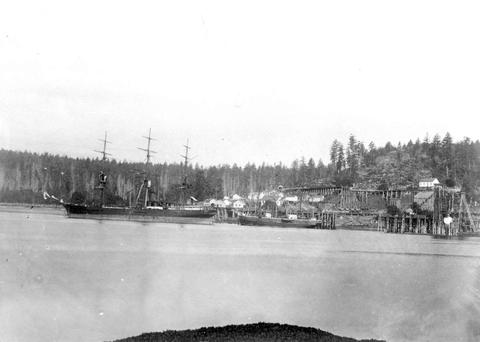
A clipper ship at the coal wharves in Departure Bay, Nanaimo circa 1886-7
To the Editor of the Alta—Dear Sir: It gave me the greatest pleasure to-day — on this the anniversary of your national holiday— to see the flags of the two great and mighty people of America and Great Britain floating side by side, and thus proclaiming to the world how harmonious was the touch that exists between us, and this I sincerely and earnestly hope may last to the end of time!It is on occasions like this that the true feeling of the great Anglo-Saxon-speaking race proclaims itself, and shows that the only rivalry now existing between us is the generous strife of maritime trade and commerce, that commends itself to the best instincts of those engaged in the struggle, however intense it may be.As one who has received much kindness and courtesy at the hands of Americans at various times and respecting your many institutions, that are framed to meet the aspirations of a great and progressive people, and only fail when they are misinterpreted by those who mistake true liberty for unbridled license, I trust to see many similar demonstrations of mutual respect and amity, to strengthen and cement the happy bond that binds us together, and to soften any mutual austerities that may exist, but which I firmly believe are due to individual more than to national causes.I am, dear sir, yours very truly,James L. Dunn, San Francisco, July 5, 1886. Ship Titania.
(Source: Daily Alta California, Volume 41, Number 13462, 6 July 1886)

The Titania arrived with general merchandise for sale
for H.B.C on 08/09/1887

Ewan & Co's Salmon Cannery, near New Westminster, BC, circa 1887
Photograph by: William McFarlane Notman
(Source: Musee McCord Museum - View 1782 © McCord Museum)
Alexander Ewen, was a native born Scotsman. who at an early age joined his father in the salmon fishery, eventually becoming foreman of a chain of fishing stations along the east coast of Scotland. He came to colonial British Columbia in 1864 after having answered an advertisement in Scottish newspapers for a superintendent of a salmon-curing venture on the Fraser River. The business, started by a former Cariboo miner, Alexander Annandale, failed after one season, reportedly because the mainstream of the Fraser was unsuitable for the fixed Scotch trap-nets used. Ewen stayed on as one of a group of fishermen, centred in New Westminster, who supplied the local fresh-fish market and salted salmon for export. By 1870 he had formed a partnership called Ewen and Company with another fisherman, William “Dutch Bill” Vianen. Ewan eventually went into the canning business and a separate entity with several other partners, who he eventually bought out.

Salmon Can Label - "Fresh Salmon, Ewen & Co., New Westminster British Columbia." (c. 190-) (Source: Courtesy of BC Archives)
Thomas was involved in the building and operation of one of the first canneries on the lower Fraser River, the Delta Canning Company, at Ladner's Landing in 1878. Ladner, R.P. Rithet and associates later formed the Victoria Canning Company Ltd., the operations of which fell on Ladner as general manager. The company eventually controlled nine canneries five of which were on the Fraser River: the Delta, Holly, Laidlaw, Harlock, and Wellington canneries. Ladner also served as the president of the British Columbia Salmon Canners Association, traveling to Ottawa to lobby on behalf of the canning industry. In 1902, suffering from ill health, Ladner retired from the Victoria Canning Co., and the business was sold to the British Columbia Packers' Association. After retiring from the cannery business, Ladner's health improved, and he concentrated on the development of his farming operation and real estate business.

Delta Canning Co. Label - "Maple Leaf Brand" (Source: Courtesy of BC Archives - I-61084)
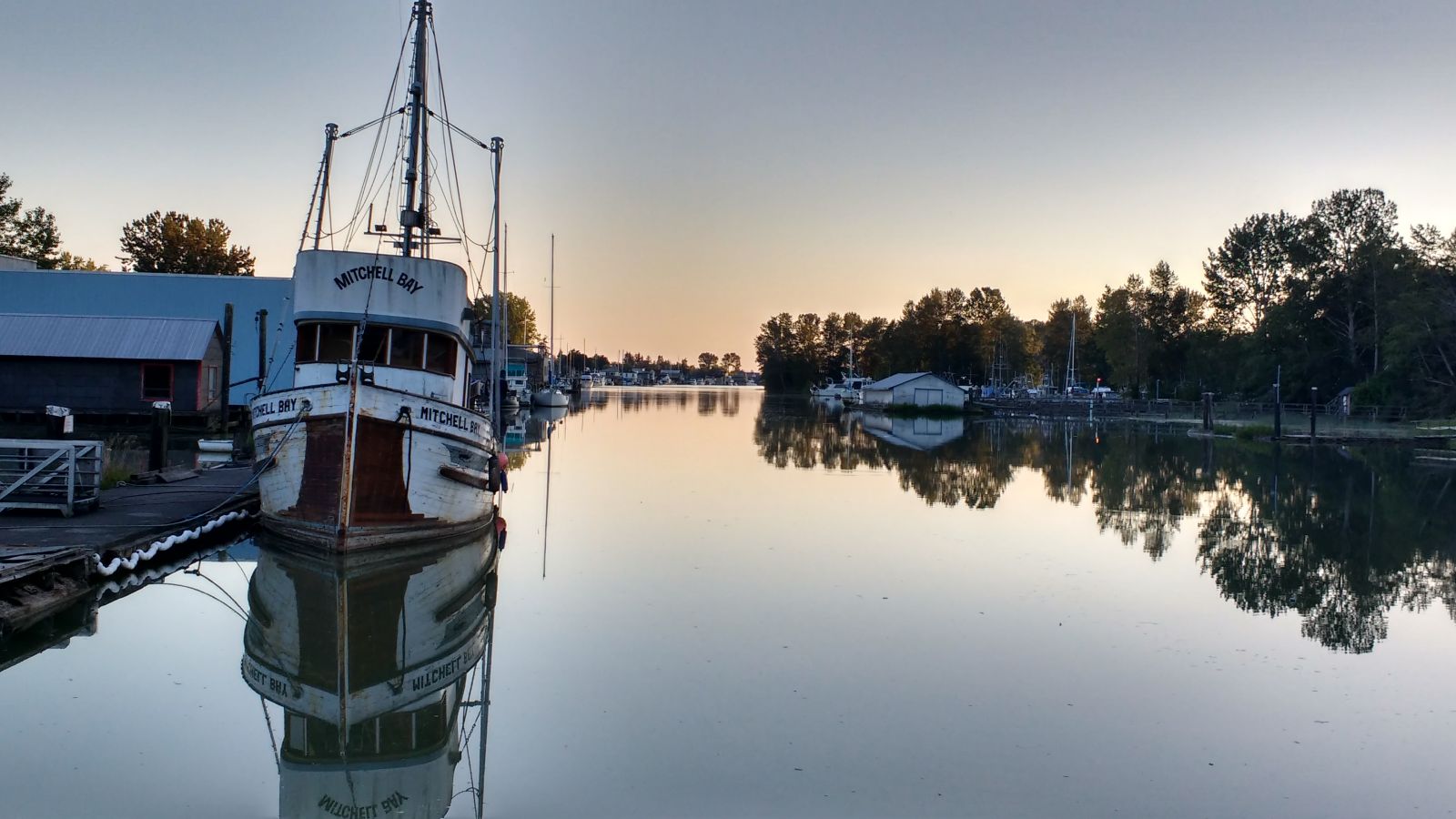
Ladner Landing - As it appears today was the former site of the Delta Canning Co. in 1887.
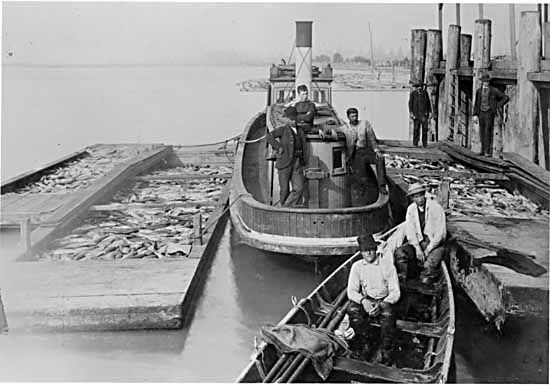
Fish at the Delta Cannery at Ladner Landing circa 1880-1889. (Source:Delta Museum and Archives Society)
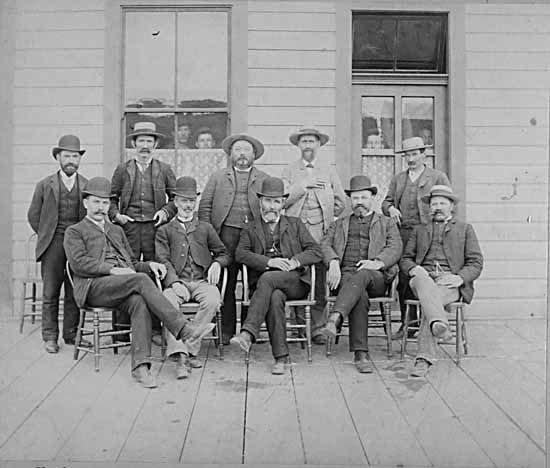
This photograph was taken of the prominent owners of fish canneries in the Delta area in 1887.
Front row: D. Munn, E.A. Wadhams, Alex Ewen, M.M. English, Ben Young.
Standing (back row): Mike Leary, H. Harlock, T.E. Ladner, J.H. Laidlaw, R. Matheson.
At window (left): E.A. Rousseau and E. Ferriere.
(Source: Delta Museum and Archives Society photograph collection #1982-14-1)
On September 10th, 1887, the Hudson's Bay Steamer, Princess Louise chugged up the Fraser under the command of Captain Meyer with the crew of the screw steamer Sardonyx. She was slightly delayed coming down from New Westminister owing to the wind, and the extremely low tides, but returned to Victoria on September 12th loaded "to the guards" with salmon from Ewen and Delta canneries.
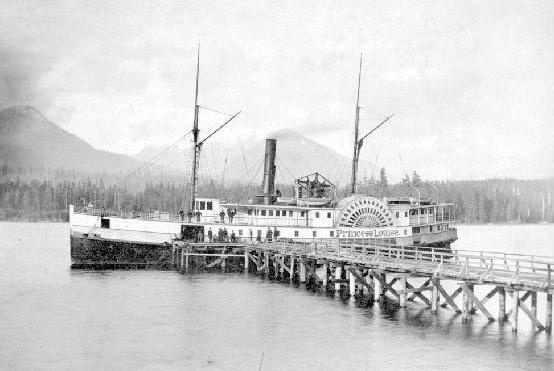
"Loaded to the Guards" the steamer Princess Louise brought
canned salmon from the Fraser River Canneries in 1887 to be loaded on the Titania.
(Source: BC Archives Image- A00190)
All in all, the Titania was loaded with 33,650 cases of Salmon consigned to London, 76 packages of furs, 4 cases of labels, some rifles, cartridges, pictures and personal effects. The total value of the cargo and goods was estimated at $239,734.40.

"British Columbia Salmon" from Fraser River canneries was loaded on the Titania bound for Liverpool in 1887.
Capt. Dunn was well known for welcoming locals to tour the famous clipper while in port.
(Source: Daily Colonist - 09.24.1887)
Clipper Titania - Part 2
The Titania made the run from Victoria to London in a record 104 days, arriving on January 9th, 1888. The local newspaper in Victoria when hearing the news remarked, that "...the Titania is doubtless the fastest, if not the handsomest, sailing ship afloat.
.jpg) 33
33
"The British Ship Titania's Fast Passage to London"
(Source: Daily Alta California 18 January 1888)
In spring, the Titania was again loaded with a cargo of general merchandise and gas piping and set out for Victoria. However, the voyage was fraught with challenges. Captain Dunn stated, "it was the roughest passage he ever experienced." It was a succession of storms from beginning to end, and at one time she had to navigate a blinding snow storm. She encountered countless thunder and lightening storms. One of them just off the horn seemed to concentrate all of its energies on the ship.
Captain Dunn describes storm, "the ship was every few seconds illuminated by lightening flashes. As there was a large quantity of powder on board the situation was not a very pleasant one." During one particularly frightful play of lightening, the captain who was standing on deck, suddenly he seemed to be surrounded by fire accompanied by a deafening explosion. He fell to the deck and when he recovered consciousness, he got on his hands and knees, but could not distinguish anything. The lightening had temporarily blinded him! He asked the direction to his quarters and groped there on his knees. It was a day before his sight gradually returned and some time before he all together recovered.
In spite of having a tough time of it, the Titania was able to make the passage to Esquimalt in 121 days, with the best run in any one day being 260 miles. The Titania was carrying a full cargo and because she was designed and built for built for speed, she was low in the water and cut through the heavy waves. Everything on deck and the quarters was constantly wet, although the cargo arrived without damage.

Liquors, and General Merchandise were brought from
England by Titania and sold by the Hudson's Bay Company in Victoria.
(Source: Daily Colonist - July 31, 1888)

Pianofortes were also on the Titania's cargo list that year.
They arrived in perfect condition despite the Titania's hair raising voyage.
(Source: Daily Colonist - September 23 1888)
The Titania was once again chartered to the British Columbia Salmon Fleet by Findlay, Durham, Brodie & Co. in 1888. In all, she was loaded with 33,782 cases of Salmon from Fraser, Skeena, and Nass Rivers, Smith Inlet, Rivers Inlet and Lowe Inlet, and Alert Bay. She also carried a quantity of furs with the total cargo worth an estimated $250,000.

The salmon was brought over to Victoria by steamer from the Fraser mostly by the Princess Louise.
.jpg)
The Princess Louise brought salmon from Fraser River canneries.
Source (Daily Colonist - Sept. 22nd, 1888)
In 1888, the total breakdown of salmon cases carried to England by Titania was as follows:
Robert Ward & Co. --- 10,932 cases
Findlay, Durham, & Brodie --- 10,600 cases
Welch, Rithet & Co --- 8,000 cases
Turner, Beeton & Co. --- 3,250 cases
E.A. Wadhams --- 1,000 cases
She arrived in Gravesend on Jan. 19, 1889 making the run back to England in 119 days. She then departed London on Mar. 7th, with another cargo of merchandise and gas piping for Victoria. She passed the Atlantic equator on April 3rd and then rounded the horn. She was making a good go of it, and on May 8th, the Titania had arrived in lon. 83 w. only 57 days out. This was two days shorter than any other run. But, her good fortune had run out, and she was battered by a series of wild northwesterly storms.
The storms would not subside, and for a month straight the Titania battled enormous waves, tides, and seas. It was nearly 40 days before she crossed the Pacific Equator, and she finally made Cape Beale on the Northwest Coast on July 10th. Upon her arrival, She was beset with heavy fog, forced to heave to and was taken in tow by the American tug Richard Holyoke, past Race Rocks into Royal Roads. She was brought into Esquimalt by the tug Pilot, and arrived in Victoria on July 12th.
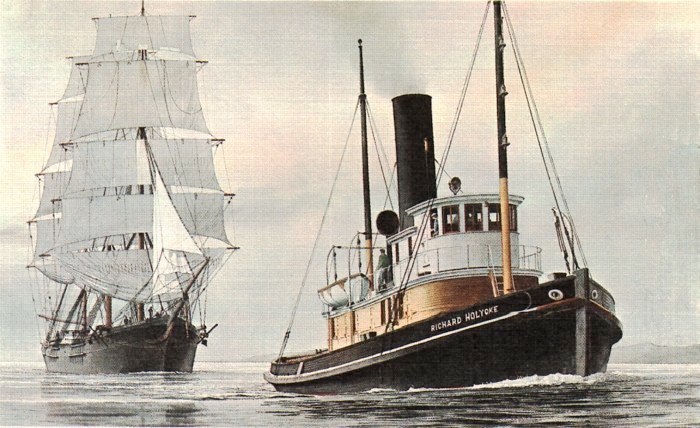
The steam tugboat RICHARD HOLYOKE tows a sailing ship through the Straits of Juan de Fuca.
San Juan Island in the background to the north - Contemporary watercolor by Steve Mayo.
(Source: http://www.stevemayoart.com/)
The Titania was once again consigned to the Salmon fleet for 1889. For the first time the Titania was carrying cargo and general merchandise for the newly formed city of Vancouver.
Henry Ogle Bell-Irving, had chartered the ship, and on July 25th it was towed to the Bell-Irving and Patterson Wharf which was at the foot of Abbott St by the newly launched tug Lorne with Capt. Urquhart as the pilot.
Originally launched in 1889 by local coal barons James Dunsmuir (1851-1920) and his brother, Alexander, Lorne was the biggest, strongest, and most expensive tugboat in the area.

The steam tug Lorne, the biggest and strongest tug in the area,
towed the Titania up the Fraser to the New Westminister and the canneries in Steveston.
The Titania had 900 tons of cargo for Bell-Irving in Vancouver, and 600 tons for the New Westminister Branch. While in Vancouver, Capt. Dunn invited the public aboard the clipper. According to the Vancouver Daily World, she was then taken up to New Westminister and on her way down the Fraser made a stop to pick up canned Salmon directly from the Steveston Canneries.
By September 20th, she was back in Esquimalt waiting for cases of salmon to complete her cargo from the Phoenix cannery that were being brought over the Strait of Georgia by the steamer Yosemite, for both the Titania and the German barque Hustede.
In 1889, Bell-Irving had purchased nine canneries in and around the newly formed town of Steveston, and in that same year William Herbert Steves the eldest son of Lulu Island pioneer, Monah Steves, laid out the town of "steves" and incorporated the village of Steveston.
A young entrepreneurial man, at age 29, he envisioned that the town of Steveston would become a major seaport terminal expected it to rival the fledgling seaport of Vancouver, which had incorporated just three years earlier. He mortgaged himself with land purchases and speculative business dealings. The fledgling township would soon live up to the founders expectations.
In 1890, new wharves, fish camps, canneries, and boat yards were built along the waterfront which created a boom for salmon canning companies, industrialists, and fisherman. In 1891, W.H. Steves would start the town newspaper, the Steveston Enterprise.
In that same year, a natural gas reserve was discovered and used to "illuminate" the town, and Steves boldly declared, "Vancouver will be a future suburb of the city of Steveston." It was not long before the town of Steveston had gained the nickname, "Salmonopolis".
.jpg)
An 1891 advertisement for an auction for land lots from the Daily Colonist. After discovery of a natural gas reserve, it was speculated that Steveston was destined to become "a manufacturing centre, and [a] centre of the leading cities of the Province."
.jpg)
A view of the Steveston waterfront circa 1890.
(Source: Vancouver Archives - Item Out P674
Original photograph property of Mrs. Ida B. Steeves)
In 1889, the largest and oldest cannery in Steveston was the Phoenix cannery, managed by Marshall English. It packed a total of 20,917 cases of salmon that year, but only 2,300 cases were shipped aboard the Titania. The majority of the canned salmon from the Phoenix cannery was carried on the newly built German barque, Hustede.
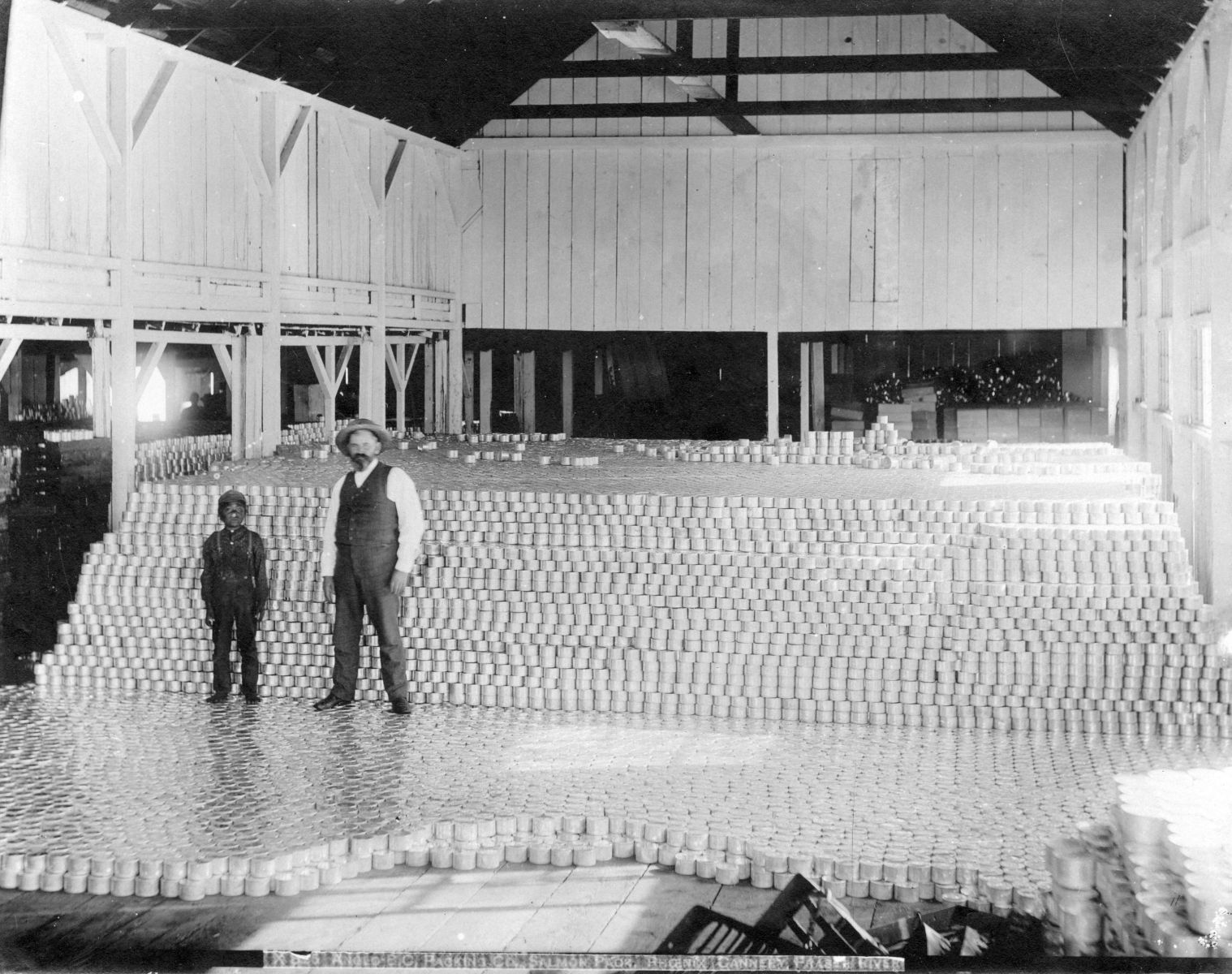
Marshall English in front of the Salmon Pack
at the Phoenix Cannery circa 1889-1890
(source: BC Archives Item A-06838)
In 1889, four new canneries were built along the Fraser. Although Steveston had nine canneries by 1889, most of the Fraser River salmon carried on Titania was packed upriver in New Westminister, and across the south arm of the Fraser in Ladner's landing.
One the the largest packs carried on the Titania was picked up for the first time from what was known as the North Branch of the Fraser River at the fledging Sea Island Cannery, which was built and operated by Alexander Ewen & Daniel Munn, on Swishwash Island, a small island located between Terra Nova on Lulu Island and Sea Island, on what is now considered the "Middle-Arm" of the Fraser. In the heydey of 1889 the cannery was a bustling place, and packed a total on 18,225 cans, which made it one of the bigger cannery operations on the Fraser that year. The cannery did not last long, as the small low island was prone to flooding, and it eventually burned to the ground in 1899.
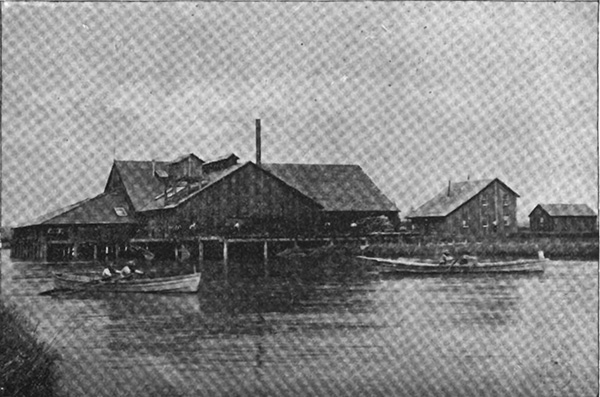
The Sea Island Cannery known as Munn's was located on
Swishwash Island. Circa 1890 (Source: Victoria Illustrated, 1891)
In a newspaper article written in 1891, the Sea Island Cannery operation is described in a voyage up the river:
"Bright and early on a Wednesday morning, we were on board the Bon Accord bound for Sea Island. We steamed down the North Branch. The view there was pleasant and the scenery in many places delightful. On our way we passed fisherman attending to their nets as they drifted down the river. One or two of them were hauling in but disappointed to see no fish. At the Sea Island Cannery, which has a small island all to itself, there was what appeared to us a pretty fair heap of salmon, and the hands were already at work cleaning them and preparing them for cans. We will not undertake to say how many hands a can of salmon must go through before it is ready for the market but there must be a good many more than the old fashioned pin, of which we heard so much in our boyhood's days. The scene in the cannery when we entered it was a lively one. Men and women were working for dear life. The first process was taking the heads off the fish, stripping them of theit fins and cutting off the tail. We watched the process for some time narrowly. The men are armed with formidably looking knives and do their work with such great rapidity."
In 1889, the Titania again made headlines as she carried a total of 33,721 cases of salmon, and 84 packages of furs along with personal effects and a case of can labels. The total value of the cargo was in 1889 estimated to be at $268,882. (approx. the equivalent of $6.5 million in 2016)
| Salmon Manifest for Clipper Titania 1889 | |||
|---|---|---|---|
| Shipper | No. Of Cases | Marks / Cannery | Est. Value |
| Blum, Baldwin & Girvin | 1,600 | B.A.P. Co. | $6,400 |
| Findlay, Durham, & Brodie | 1,000 | Alert Bay Cng Go. LA | $6,000 |
| Findlay, Durham, & Brodie | 447 | Oweekayno River | $3,129 |
| Findlay, Durham, & Brodie | 1,000 | Windsor Cannery, H W | $6,000 |
| Findlay, Durham, & Brodie | 600 | Windsor Cannery, H W | $3,600 |
| Findlay, Durham, & Brodie | 500 | Rivers Inlet Cnry DJF | $3,000 |
| Findlay, Durham, & Brodie | 1,000 | N. Pacific Canning Co. | $6,000 |
| Findlay, Durham, & Brodie | 1,000 | H--C | $6,000 |
| Robert, Ward & Co. | 1,200 | Express Brand, "W" | $6,600 |
| E.A. Wadhams | 250 | A.F. | $1,000 |
| E.A. Wadhams | 250 | B.F. | $1,000 |
| E.A. Wadhams | 500 | E.E. | $1,000 |
| Findlay, Durham, & Brodie | 1,000 | G.H.F. | $2,000 |
| Findlay, Durham, & Brodie | 1,000 | G.H.F. | $2,000 |
| R.P. Rithet & Co. | 1,500 | Harlock Packing Co. | $9,375 |
| R.P. Rithet & Co. | 1,500 | Laidlaw & Co. | $9,375 |
| R.P. Rithet & Co. | 1,500 | Delta Canning | $9,375 |
| R.P. Rithet & Co. | 1,500 | Wellington Pkg. Co, | $9,375 |
| R.P. Rithet & Co. | 1,500 | Skeena Packing Co. | $9,375 |
| R.P. Rithet & Co. | 2,000 | Phoenix Brand | $12,500 |
| E.A. Wadhams | 250 | C.F. | $1,000 |
| E.A. Wadhams | 250 | H.H. | $1,000 |
| E.A. Wadhams | 250 | J.J. | $1,000 |
| E.A. Wadhams | 250 | K.K. | $1,000 |
| Findlay, Durham, & Brodie | 924 | Rivers Inlet Cannery | $5,544 |
| Robert, Ward & Co. | 1,000 | E.E. | $5,500 |
| Robert, Ward & Co. | 1,600 | E.E. | $8,800 |
| Robert, Ward & Co. | 2,000 | Sea Island Cannery | $11,000 |
| Robert, Ward & Co. | 2,200 | Sea Island Cannery | $12,100 |
| Robert, Ward & Co. | 1,000 | R.W. | $6,000 |
| Robert, Ward & Co. | 1,000 | R.W. | $6,000 |
| Findlay, Durham, & Brodie | 1,000 | G.H.F. | $6,000 |
| Findlay, Durham, & Brodie | 850 | G.H.F. | $5,100 |
| R.P. Rithet & Co. | 300 | Phoenix Brand | $1,875 |
| Totals | 33,721 | $194,023 | |
Indeed, the salmon run was a "bumper crop" that year, Thomas Mowat in his report to Charles Tupper, the Minister of Fisheries and Marine, wrote: "SIR,—I have the honor to transmit my annual report on the fisheries of this Province for the past year, with statistical returns and condensed reports from the several guardians. These returns show a much larger increase in value than that of any previous year since fishing operations commenced in this Province... The residents on the Fraser are unanimous in the belief that never before in the history of the river was there such an exceptional run."
Before leaving Victoria, Captain Dunn wrote a small farewell poem that was published on September 24th, in the Daily Colonist:
Farewell to Victoria 1889
Kind friends in Victoria, the time is now nigh,
When, sailing for England, I must bid you
good bye;
But, shall carry this feeling, you must not
think me vain.
Next year you'll be pleased to see me again.The beautiful clipper I'm proud to command
Four times has returned to this much
favoured land;
The "Titania'' is now a true household
word.
For she's tight, staunch, and strong and
fleet as a bird.Yet, oft I'll remember those bright happy
hours
I've spent in your homes all embosomed
with flowers;
For this is the rule and is no vain boast,
"To welcome the stranger who visits your
coast."In Grandeur sublime, majestic and high.
Mount Baker uplifts its proud peak to the
sky;
Whilst the mounts of Olympus, from
Heaven's blue dome.
Keep watch o'er the Straits that front your
sweet home.Victoria, fair city ! I predict that kind fate
Your childhood will change to a prime
that is great;
Here's success to all those that in you now
dwell.
Accept my best wishes, God speed you,
farewell.James L Dunn,
Ship "Titania."
Esquimalt, Sept. 22nd. 1889
In an extremely rough sea, the Titania was towed out by the tug Lorne on October 3th, to Cape Flattery at midnight, in a frightful storm. Capt. Christensen of the tug Lorne pronounced that it was the fiercest gale that he had ever been out.
Despite, the heavy seas the tug made an average of 7-8 knots with the fully-rigged and heavily laden clipper in tow. Captain Dunn, was determined to try and break his old record and proudly stated he planned to make the run under 100 days. The Danish bark Doris Brodersen left a few days after and her captain vowed to overtake the Titania her on the way home to London.
The German bark J.Hustede, departed on October 13th, and was loaded with 56,000 cases of salmon bound for London. Captain Reimer proudly proclaimed that he would make the best time ever made for the trip home and not only boasted that he would beat the Titania's time, he wagered $100 that he would also beat the Lebu which had departed Victoria for London the same day. The salmon race was on!
While not breaking any records, the Titania's time for the return trip was 110 days which was considered particularly good and she was the first of the salmon fleet to arrive in England that year. The Lebu, also had a decent showing making the run in 132 days and brought home a load of British Columbia salmon worth $182,305. The Doris Brodersen was long overdue and did not arrive until 190 days after her departure, just as the Titania was preparing to depart back to Victoria.
The German bark J.H. Hustede, with 56,000 cases of salmon worth $330,998, never arrived, and has never been heard from or seen again. It is presumed that all hands were lost at sea. No trace of the wreck has ever been found. It was thought that she may have listed in a storm and was not able to right herself, in this manner she would have sunk straight to the bottom with no wreckage.
Two other clippers, the Norcross and the Thyonus made the run the run later in the the year.
The Titania left England on April 28th, 1890 with 1,200 tons of general merchandise, with 1,100 destined for Victoria, 50 for New Westminister, and 50 tons for Vancouver. She was towed into Esquimalt on September 03, 1890. She made the run in 120 days. She was under charter for Bell, Irving and Patterson for the salmon trade.
Henry Ogle (H.O.) Bell-Irving, was one of the most influential businessmen to emerge in Vancouver. A restless young entrepreneur hoping to regain clear title to his father's estate at Milkbank in Dumfriesshire, near Lockerbie in the Scottish Lowlands, he correctly discerned that British Columbia's infant salmon canning industry offered tremendous potential for making money. In the fall of 1890, Henry Ogle Bell-Irving with help from family and friends in Scotland, secured the capital to consolidate nine west coast canneries, seven of them on the Fraser River, into one corporation, the Anglo-British Columbia Packing Company Ltd. At the outset Anglo-B.C. Packers, which Bell-Irving managed through his agency company in Vancouver, was "the world's No. 1 producer of sockeye salmon."

New Westminister waterfront circa 1889-190
(Source: B.C. Archives)
In early October, the Titania arrived at the C.P.R. Wharf in New Westminister to discharge cargo, and pick up a load of Salmon and Lumber. On the evening of October 14th, Captain Dunn was in a particularly high spirited mood. He had just received a letter from his family reporting everything well, and eagerly waiting for his happy to return to old England. He had at home a wife and four children. The captain was a bluff, hearty, kind man, and could not contain his joy moodily to himself, and he freely informed his friends of the happiness that the contents of the letter had brought him. That night he went to attend a performance at Herring's Opera House. The Herring's Opera house was built in 1887, and was a frame structure 150ft x 50 ft. and was located on Prevost st. (Carnavaron st. & 6th).
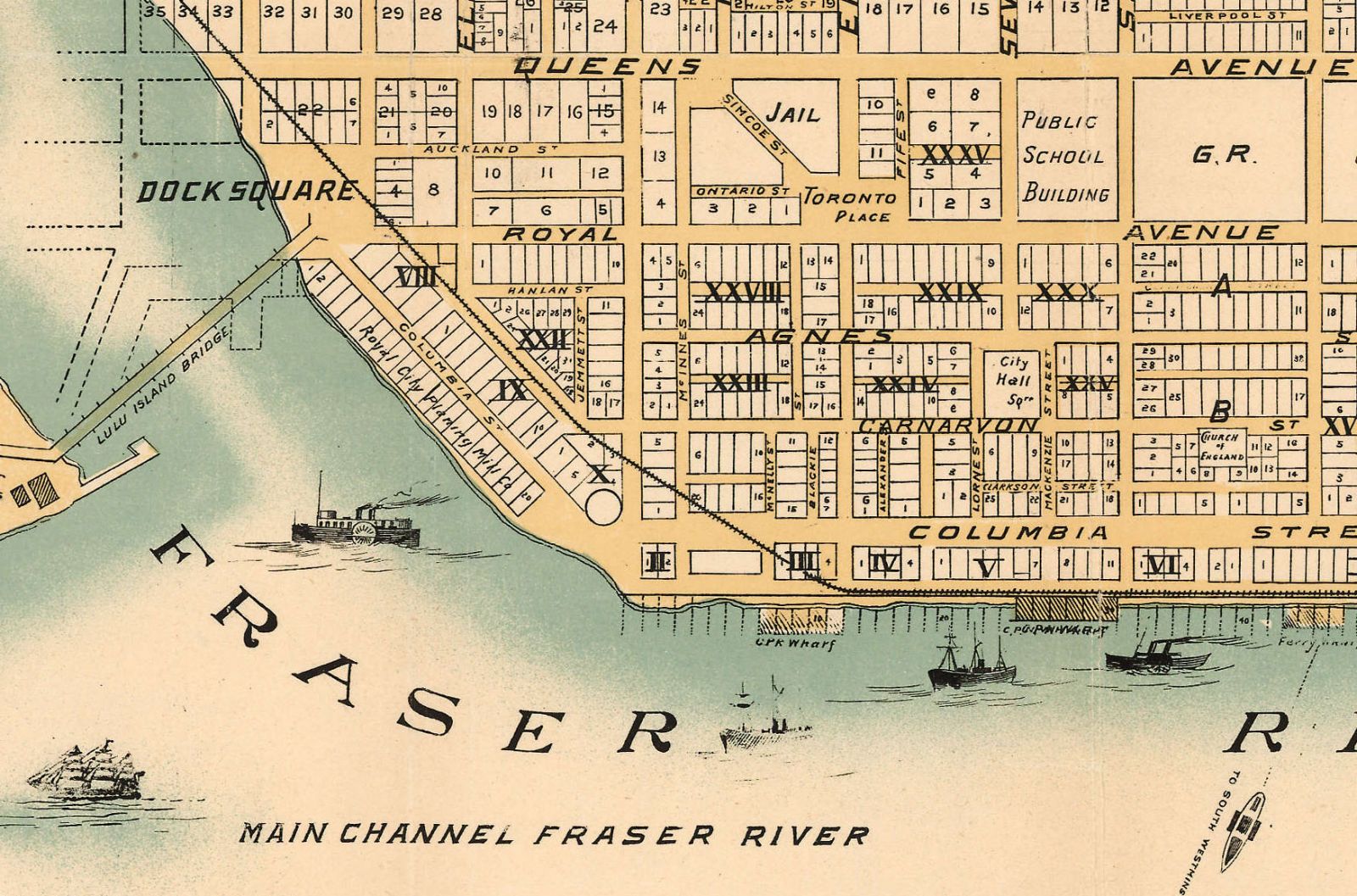
The New Westminister Waterfront Map, 1892
(Source: City of Vancouver Archives - Item Map 912)
The Herring's Opera House is described in The Weekly News Advertiser, "It has an auditorium capable of seating 800 persons and a gallery of 300 persons. The seats are moveable, so as to allow being taken out and are on an incline place ascending to the rear. There are four proscenium boxes, a handsome drop curtain costing $900, the painting representing the Bay of Naples; a stage 50 x 35 feet, dressing rooms attached, a curtain opening of 30 feet and a good stock of scenery". The Opera house was destroyed in the great fire in 1898 that destroyed most of the City of New Westminister.
.jpg)
Columbia Street in New Westminister, circa 1890.
(source: Vancouver City Archives)
Captain Dunn went to the Opera house with several of his acquaintances and friends, who said they never saw him so jovial and happy. He was accompanied by Mr. R. McFarland (an agent for Bell-Irving, Patterson, & Co.), and enjoyed the play very much. He left the theatre at 10:30PM. On his way back to the ship he met Mr. A. Ewen and D. Munn who owned the New Westminister cannery operation, and Sea Island Cannery on Swishwash Island. He engaged in a lengthy conversation, and left the club about midnight. Mr. Ewen saw Captain Dunn off at the corner of Columbia and Begbie streets where he bid him a fine farewell. Mr. Ewen made his way up Columbia to his own residence and Captain Dunn proceeded westward down Columbia towards the wharves.
He walked through a gate to the pier, and crossed the railway tracks, passing between two railcars that had been left close to the station, and proceeded to the dock. Unfortunately, for Captain Dunn, workmen had been been working on an extension of the dock. They had stopped worked the previous evening and left a gaping hole of about 20ft in size in the boardwalk that dropped 6ft to the pile of rough cut timber piled below. With the lighting partially obstructed from the railway cars, and in the rain with no fencing or warning signs that the dock dropped off, Captain Dunn fell through off the pier, through the hole and cracked his skull on the pile of timber below. He died from his injuries and was found in the morning.
The loss of Captain Dunn was a shock in both New Westminister, and in Victoria. The flags of all the masts of the ships in both shipping harbours were lowered to half mast. His body was brought to the Ross Bay cemetery in Victoria, the following day, and the funeral took place on October 18th. It was said that he was so well liked by the citizens and crew that his casket was practically hidden from view from the enormous amount of flowers.
Meanwhile, the Princess Louise had made it up to New Westminister with a load of canned salmon from the Northern canneries for the Titania.
The command of the Titania was passed to the first mate Henry Norman. Ironically, Captain Norman about a week after his appointment walked off the pier in the same spot as Captain Dunn, and fortunately he escaped the incident with scrapes and bruises.
The Titania finally departed Victoria, towed to sea by the tug Pilot on November 21st, 1890. The Titania carried a larger pack from the Steveston canneries than ever before. The Fraser fishing industry was booming, and had became centered around Steveston whose waterfront was dubbed, "cannery row".
| Salmon Manifest for Clipper Titania - 1890 | |
| Shipper | No. of Cases |
| Findlay, Durham, & Brodie | 8,000 |
| Canoe Pass Canning Co. | 748 |
| M.M. English & Co. | 1,500 |
| Duncan, Bachelor & Co. | 12,250 |
| J.H. Todd & Co. | 3,000 |
| Garry Point Canning Co | 9,149 |
| Totals | 34,647 |
The Titania loaded salmon for the first time from the newly built Britannia Cannery, constructed by W. Duncan, J. Bachelor, Eli Harrison. In June, 1879, William Duncan made his way westward to New Westminster, British Columbia, and was employed as bookkeeper at the salmon canneries, while later he served in the same capacity in the Royal City Planing Mills until February, 1890. He was then instrumental in organizing a company under the name of Duncan, Batchelor & Company and built the Britannia cannery at Steveson, British Columbia. The Britannia cannery was a L-shaped structure built next to Marshall English's Phoenix Cannery. It was sold a year later to H.O. Bell-Irving's, Anglo-British Columbia Packing Company in 1891.
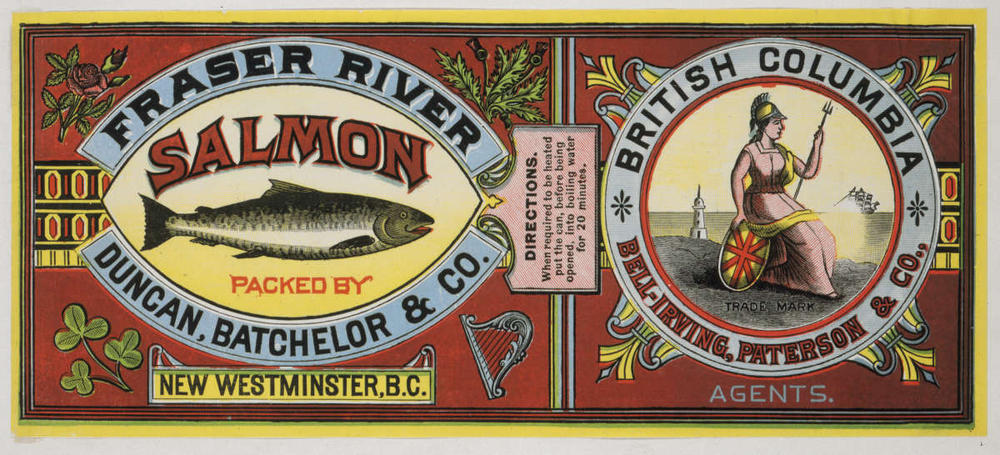
A can label from Duncan, Batchelor & Co.who built and operated the
Britannia Cannery in 1890.
(Source: British Columbia Archives)
Another newcomer to the Steveston cannery scene was J.H. Todd, who was an Ontario farmer who had made a fortune in Barkerville during the Cariboo gold rush, selling provisions to miners. (His grocery store remains a heritage site in Barkerville today.) He moved to Victoria to establish a dry-goods store on Wharf Street, but in 1882, when he saw the rush to the fishing business, and put his wealth into a cannery of his own on the North Arm of the Fraser River, near Richmond, where he opened the Richmond Cannery. In 1889, he expanded his operations and opened the Beaver Cannery near what is now the end of No. 2 road. The Beaver Cannery was later renamed Richmond Cannery, when the cannery on the North branch of the Fraser closed in 1905.
Todd didn't’t know much about fish, but he did know how to run a profitable business. Canneries were exempt from the labour laws of the time, so he hired Chinese and Indian workers exclusively, and built up a fleet of his own boats, each flying his horseshoe logo (a tribute to miners’ superstition), to supply the cannery with fish. Todd, was a shrewd businessman who always paid by the piece and never by the hour, and it is said that he once commandeered two young aboriginal men to paddle him from all the way from the cannery to New Westminster – a considerable task, against the Fraser's current and at the end of the journey he rewarded them with two pieces of hardtack biscuits.
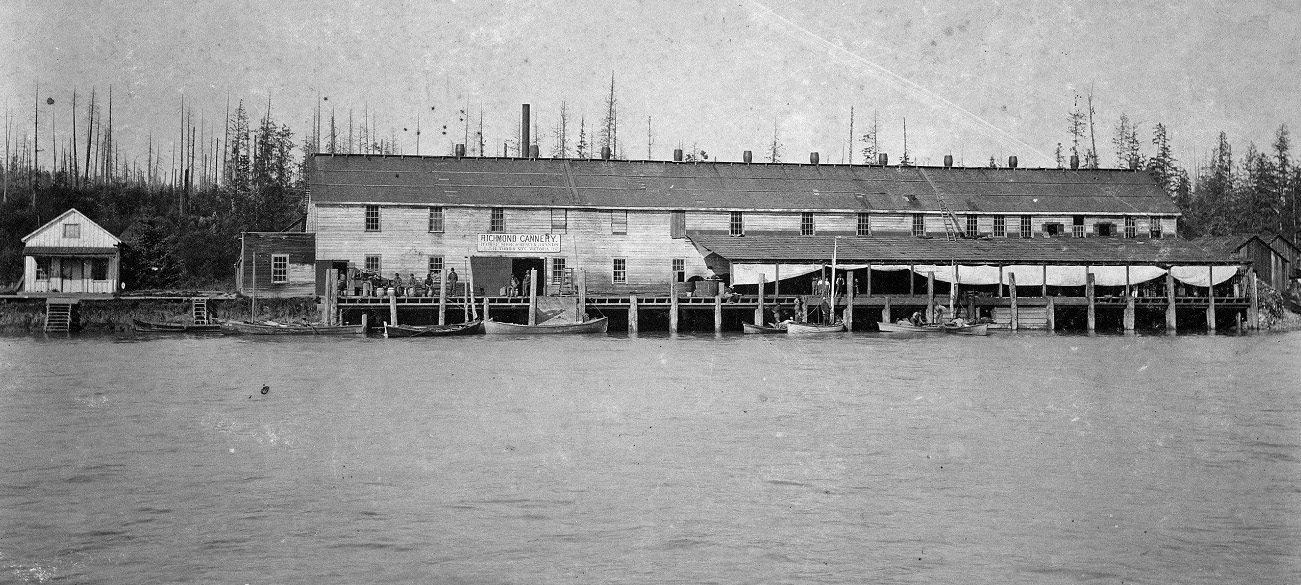
The Beaver Cannery was renamed Richmond Cannery in 1905 when the
Richmond Cannery on the North Arm of the Fraser was closed. (Source: B.C. Archives)

A clipper tied up to a cannery at Steveston circa 1890-1900.
(Source: B.C. Archives)
The Titania arrived in London on March 24, 1891 and had made the run in 123 days. The value of her cargo of salmon was estimated at $178,000. Thomas Selby who had been first mate on the Titania's rival, Cutty Sark, was then given command of the Titania. Selby was known for his hard-work and dedication. He joined Cutty Sark in February 1886, aged 20, and sailed on her for two voyages as 2nd Mate, then three as 1st Mate from 1888.
He was a very highly regarded officer. Despite his youth, he was extremely conscientious and kept Cutty Sark in excellent condition. When in port, he would row out in a boat every evening to inspect her. Although strict and hard working, he had no false dignity and was popular with the crew and apprentices. He was athletic and enjoyed boxing whilst in Sydney. He was also a marlinespike seaman, skilled at rope and knot work.
While being hard-working, he was also easy-going and knew when to have fun. Captain Woodget, of the Cutty Sark who was considered one of the most successful masters in her career, invited Selby to join him in roller skating around on the teak decks, a favourite past-time of Woodget's when the Cutty Sark was in port. Once, the Master persuaded him to try it with him on the teak deck of Cutty Sark. Thomas’s head hit the deck and nothing would induce him to try again.
The Titania set sail from London in April with a cargo of of general merchandise for Victoria, New Westminister, Vancouver and the Navy Yard in Esquimalt. The voyage was splendid until she reached Cape Horn, when for two weeks she encountered a series of heavy gales. The trip was made in a good time of 108 days, and arrived at midnight on November 7th, 1891.
Titania was brought around the Hudson's Bay Wharf, and then towed over to the lower mainland. In July, the Hudson's Bay Company had announced that they no longer were using the Titania for transporting furs. They were now to be carried overland, the Titania was only to be carrying "salted hair seals but none of the furs."
The days of the mighty clipper were coming to an end, and there was alot of speculation that unless the market improved soon that the Titania would soon be taken out of service, and not return the following season. In 1891, the Fraser salmon pack early returns weren't very good. Mr. Todd reported, "so far the pack on the river is very small, and the prospects are that fully half the cans which have been prepared will have to be carried over, unfilled until the next year." While tied up in New Westminister it was said that Titania had a "broom tied to her masthead".
Having a broom tied to the masthead, is a curious old naval tradition that we are given to understand that the vessel bearing it is for sale. This singular method of announcing a ship for sale has generally been ascribed to the fact that Van Tromp, the celebrated Dutch admiral, displayed a broom at the masthead of his vessel to signify his intention of sweeping the English from their own seas. That he actually did display a broom in this manner, and that is was not just an expression, is unquestionable, since, in retaliation, the English admiral tied a horsewhip to his own masthead, expressive of his determination to give the Dutchman a good thrashing. From this horsewhip, the flying streamer or Pennant which has long distinguished all English ships of war has been derived. But the broom was a very old device at the time when Van Tromp made use of it. "The Friscans," writes John Evelyn, "greatly infested the Danes, and those of Flanders, especially under William, the son of John, Count of Holland, and in the time of William the Good, Duke of Normandy. They were the first that bore the broome when, anno 1438, they had cleared the Levantine Seas, and subdued the Genoese."
However, while the broom at the masthead makes sense in terms of a naval victory or on a military vessel, the idea of an article being sold and literally "swept away" doesn't really seem very likely or logical in the context of the merchant fleet. The symbolism of the broom in connection with a ship for sale can most likely can be explained on more logical grounds. In the past, the periodical hiring of servants was intimately associated with what was called a "Mop Fair", that is those servants who have not yet found a new master are distinguished from the rest by wearing twigs or small boughs in their hats. Now, the ancient Gauls always placed boughs on the heads of their slaves exposed for sale in open market, and from this custom other objects exhibited for sale came to have boughs fastened to them. Moreover, since these boughs invariably consisted of the broom-plant, the constant use of the term "broom" was easily mistaken in the course of time for the name of that article of domestic utility with which we are all familiar. As a matter of fact, the household broom received its name from its bristles being originally made of the broom plant. Hence the designation, "Mop Fair," by which was meant a fair exclusively held for hiring and selling, without any recreative adjuncts. Thus, the broom at the mast in terms of the merchant service, indicates that a ship is in need of a new owner, or is available for service or charter.
The Titania sailed direct from the lower mainland to England, instead of loading in Victoria, the steamer Maude brought 11,000 cases of salmon up the Fraser to be loaded at New Westminister to finish her Salmon Cargo on Dec. 22, 1891.
On January, 16th, 1892 the Titania was towed out to sea from Vancouver for the last time by the tug Active. Her cargo hold was full of salmon cases, her 'tween decks was loaded with lumber, and she carried no deck load. Her cargo in total consisted of 22,365 cases of salmon worth $107,914, 12 cases of furs worth $5,300, 100 cases of champagne, sundry merchandise and 193 feet of lumber. The total value of her cargo was estimated to be $112,314.80.

The steam tug Active towed the Titania out to sea on Jan. 16th, 1892
It would be the last voyage that the Titania would make to the West Coast.
(Source: B.C. Archives Item E-02093)
The Titania arrived in London on May 17th, 1892 and made the return run in 121 days. It would be the last time the Titania would visit the Pacific Northwest. She was laid up in ordinary at London until the following year.
In May, 1893 she was sold to firm of Italian firm of P. Pollio & Co for £2000. She was put in command of Captain Antonnino Pollio and put into grain trade between Cape Town and Australia under consignment of Cave and Co.

In 1893, the Titania was consigned to W.R. Cave & Co
and placed into South African-Australia grain trade.
(Source: The Port Augusta & Quorn Dispatch 11/24/1893)
William Rendall Cave (W. R. Cave) was a grain merchant and ship owner in the early days of South Australia. In 1873, Cave founded W. R. Cave & Co., with offices at Port Adelaide and Grenfell Street, Adelaide. The business steadily expanded, especially in the grain trade with agencies throughout South Australia and branches in the other States. His partners were his son, John R. Cave, his nephew, Charles H. Warren and for a time Frederick Charles Howard. W.R. Cave owned and chartered a large number of coasting vessels throughout the 1890's and shared a wharf with the Howard Smith Co.
The Titania sailed from Cape Town to Port Augusta, arriving on October 19th under canvass and in the charge of the pilot Burton. She made the run from Cape Town in 31 days.
At Port Augusta, the Titania took on a load of wheat for Cape Town for Cave & Co. and departed on 24 November carrying 11,057 bags or 45,570 bushels of wheat. She arrived in Cape Town on Jan. 8, 1894, and departed for Australia again on Feb 5th. She arrived in Port Adelaide, on Mar. 13th, making the run in 36 days.
On April 7 , she left Adelaide to load at Sydney for the wool trade between Australia and England. She was chartered to H. King and Company, was expected to load 21,528 bales of wool, worth £210,974
By April 14th, the Titania was off Green Cape in the Bass Straits on her way to Sydney. The evening was dark with the moon obscured by clouds, a smooth sea, and a light north-east breeze. The Titania was close hauled on a starboard tack and had the right-of-way, when she was involved with a tremendous collision with the steamer Konoowara, who had underestimated the clippers speed and had attempted to cross in front of her bow.
The Titania was riding high, shipping in ballast only, and the steamer was fully laden, trimmed low in the water. The overhanging stem of the Titania with its projecting jib-boom and bowsprit raked completely across the aft of the steamer, with most of the damage absorbed by the bowstem above and below the waterline of the Titania. When the Konoowara got caught the head gear of the clipper, it slewed the later around, and wrenched the Titania's bow stem right off.
In addition, the cathead was completely broken, which caused the starboard anchor to drop, and it let out more than 100-150 fathoms of chain, bringing the Titania to a sudden stop. The hit between the ironsides of the steamer and the wooden stem of the clipper was a terrific one, and the Titania's bulwarks were stoved in, her figurehead shattered, the bow stem was wrenched right around to the portside from the figurehead all the way down to far below the waterline. Massive four inch circumference copper bolts that were bolted into the stem in the stern were twisted completely at right angles, and the planks was wrenched away from the deadwood of her keel stem, with the plank ends exposed. The water was pouring into the vessel at an alarming rate. In order to stop the leaks, every bit of scrap material, sails, canvass, etc. was used to plug the damage and keep the water out.
All hands were required to man the pumps to keep her from sinking. When the Titania was towed into port, and later examined, the surveyors and shipbuilders were amazed that she was still afloat at all. Unmeasured praise was given to the Captain and crew for their determination to keep the vessel afloat. The captain organized crews to keep the pumps manned day and until until she could be brought into dock for repair.
The Konoowara did not go unscathed, but most of the damage was limited to her upper decks and was not structural. The funnel had been knocked down, and the port side from amidships right to the aft was a complete wreck on deck. The railings, rigging and deckhouses had been swept away, The port side life-boat was smashed to pieces, and the davits were bent like reeds. Despite the damage, she was able to continue on her voyage.
The Italian Captain Pollio was very loath about giving a public statement when he came into port, without first receiving permission from the Italian consul.
However, Captain Krause was an experience pilot who was employed by Captain Pollio to bring the Titania into to Sydney, and gives this account:
"About 6:15 pm on Sunday night as the Titania was on the starboard tack close hauled with her topsails, main sails, foresails two jibs, and spanker set and the wind north by east, the ship bearing north-west by west, the light of Green Cape bearing north, half-east, the steamer Konoowarra trying to cross the Titania's bow came in collision, and carried away the ships starboard anchor, headgear and cathead, the chain running out 100 fathoms.
The ship was brought to anchor and we made an examination to see what damage she had sustained. As we found she was making-water, all hands were set going on the pumps, while the captain, carpenter, and several men went down below to clear the dunnage wood in order to get at the leak, the carpenter trying to stop the leak as much as possible.
At 11 p.m. we sounded the pump and found 5.5 in of water in the well. We kept the pumps going and kept the lower topsails set ready to slip anchor if the wind should come from the north-east-, the barometer standing at 30•20in. Two of the steamer's men-one a fireman and one a steward-jumped on board the Titania. They were set to work at the pumps.
The wind moderating a little by midnight we tried to stop at anchor as long as possible till daylight to save the ship, and see if we could better her position from outside. The distance from Green Cape was eight miles. When morning came we found the vessel was very much damaged. At 7 a.m. a steamer [Glaucus] came up, and we asked to be towed to Sydney. We gave out our hawser and the steamer did the same. When we got in tow we had to slip our anchor, as we found it impossible to get it on board as we found that the water was gaining on the ship at the rate of half an inch in hour. We kept the pumps going constantly day and night. We arrived in Sydney at 4 a.m. , and found she had then 27in of water in her hold. We anchored under Garden Island "
When asked for his opinion as to the cause of the collision Captain Krause said, "my opinion is that the steamer tried to cross the Titania's bow, thinking that the vessel was not going as fast as she was." Asked about the statement that the Titania's lights, were not burning, he said " Whatever they say about no lights burning is not true. The ship never altered her course. She kept straight on . The crew worked all day and all night to save the vessel, and they are quite worn out."
Captain Ellis of the Konoowarra had claimed that the Titania had been sailing with the steamer, and without running lights, making it difficult to see or determine her position or course of travel. He had gone below decks just before the collision as he thought that everything was in control as the Titania was not on any collision course, and did not present any clear or present danger to the steamer. It is his contention that the Titania suddenly changed course, and the steamer was unable to avoid a collision as it was traveling at full steam at nearly 10 knots. He claims that running lights were placed into the screens after the collision, to make it appear the steamer was at fault.

A lengthy inquiry was held by the marine board, and numerous accounts from eye-witnesses including crew, passengers, people on shore, and other ships were taken into consideration. The board deliberated through five-days of testimony and carefully reviewed the evidence. It determined that Thomas McCaskie, the second officer of the Konoowarra, was at fault for the accident, in having committed breaches of the sailing and steering rules, which provide that a steamer shall give way to a sailing ship, and that in approaching another ship a steamer must slacken speed. They also censured Captain Ellis for not standing by the Titania after the collision.
The Titania was pulled into Jubilee dock, where she underwent temporary repairs to stabilize her hull and possibly get her into sailing condition. The repairs lasted three weeks, but it became apparent that the damage was great, and without a drydock and complete overhaul it would not be safe to carry cargo. The decision was made to sell the ship, but it was difficult to find a buyer. It seemed her career was over, and in her darkest days it seemed that she was soon to be sold for salvage.
On June, 22nd, Captain Pollio sued the owners of the Konoowara in vice-admiralty court for wages due since May18th. Captain Pollio, commander of the vessel, who is also part owner, admitted the claims of the crew, and said he had received instructions from his co-owners to sell the ship. He was requesting the crews wages since the ruling on May 18th, and return passage for the crew back to Naples.
The steamer Glaucus also submitted a salvage claim against the owners of the Titania for recovering the stranded vessel. The plaintiffs claimed £600. It was stated that there was no dispute as to the Titania having been rescued by the plaintiffs' vessel, and the evidence as to this was taken as admitted.
Captain Hall, marine surveyor, stated that he knew the Titania well. She was before the accident in A1 condition in the Lloyd's register and estimated that the value of the vessel would be about £2200 before the collision. The repairs might cost altogether about £1000. With the high cost of repairs, he did not think anyone would give £1200 for her.
Captain Pollio, part owner and captain of the Titania, stated that he had an estimate from Mort's Dock for the repair of the Titania. Leaving out the cost of anchor and chain and rigging, &c, the estimate was £1120. The other articles were reckoned to cost £250. His vessel was insured in Italy for 48,000f.
Mr. Justico Windeyer gave judgment for the wages claimed, together with an amount sufficient to defray the passages of the crew back to Italy and he directed the vessel to be sold at auction and the proceeds paid into court, to be distributed amongst all the parties who laid claims to her. As for the Glaucus salvage settlement, it would have to wait until after the ship sold to see what she could fetch at auction.

On July 19th 1894 the Titania was up for auction after
suffering extensive damage after a collision with the steamer Konoowarra
(Source: Sydney Morning Herald, 2 July 1894)
However, the auction for the Titania did not receive any bids, and she was withdrawn from sale when the starting bid dropped below £900. It looked as those she was destined for the knackers yard. A second auction was scheduled, and she was finally sold at £580 to shipbrokers of W.H. Paxton & Co.
It was fortunate turn of events for the Titania, the low sale price gave her a new lease on life, and instead of her career coming to an end, she entered the drydock at Mort's for full repairs.
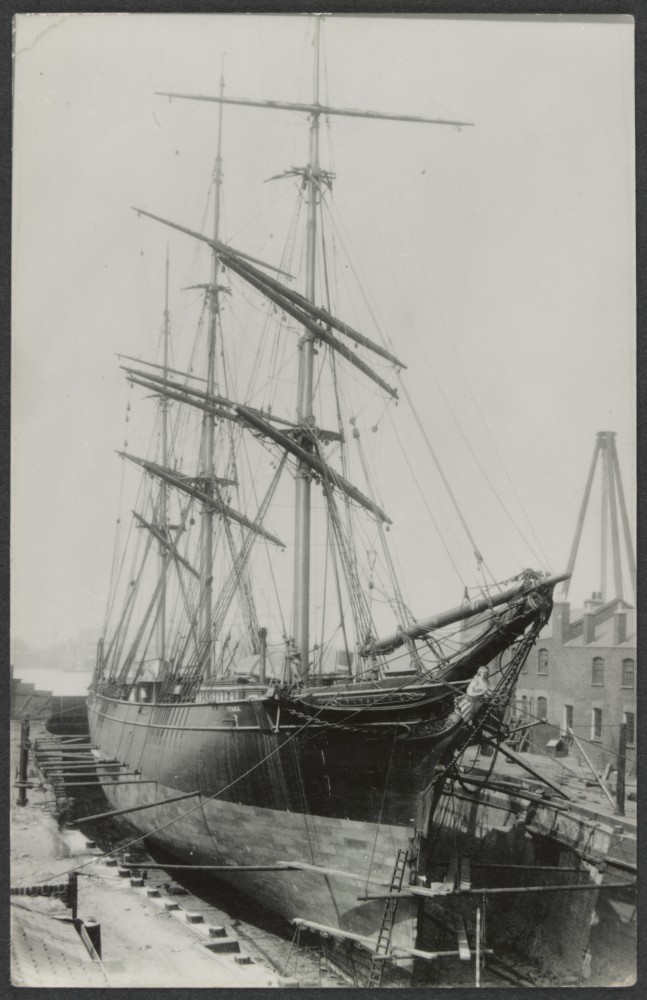
The Titania in dock in Sydney after a collision with S.S. Konoowarra off Green Cape c.1894
(Source: National Library of Australia - Item H93.8/243)
With the exception of the bows of the vessel, the hull was found to be perfectly sound, the material, both planking and the iron frames, being well preserved, showed no expense had been spared in putting the best of workmanship into the clipper. The repairs comprised of taking out the whole of the old stern, which was split right through, and fitting a new apron piece. This was a solid piece of timber being of ironbark, 22in. x 16 in. x 19 ft., with through metal fastenings. The planking on the port bow, or rather the bow itself, had been shifted away 2 in. from the fastenings, and this had to be drawn into place, 21 new planks being put in forward, viz., seven on the starboard side and 14 on the port side. The planking is of spotted gum, and was considered to be equal to teak for certain portions of a ship's plank.
On September 27th, under command of Captain Pollio, and chartered to Dalgety & Co., the Titania set sail for Fiji with a load of general merchandise to pick up copras for Europe. The Titania arrived at Suva, Fiji on October 6th, and claimed the fastest sailing record to Fiji, taking a total of 8 days and 10 hours. The account is as follows:
The Titania left Sydney at noon with a strong southerly wind and heavy sea. In the evening the wind changed to the S.E. The following were the days runs: 280, 210, 220 230,165,190,185, 270, and 120 respectively In the last half day the ship sailed 80 miles in 6.5 hours, there being heavy winds but very thick weather. The course shaped on leaving Sydney was 40 mites to the southward of Lord Howe Island, thence E.N.E to 35 miles south of Norfolk Island thence N.E and N.N.E until the eighth day, when the vessel was 120 miles almost due south of Suva.
(Source: The Sydney Morning Herald - 1/11/1894)
After unloading in Suva, Fiji. The Titania then sailed to Loma Loma, and then later Levuka and all-in-all loaded 1150 tons of Copras. Due to heavy rains in 1894, there was a bumper crop of coconuts in Fiji that year, some there were 3000 tons of Copras at Levuka, Fiji awaiting shipment. There was not enough storage on the island, which drove prices extremely low.
The Titania departed Levuka, Fiji on December 6th, 1894 for Lisbon. She made the passage in 106 days and arrived, on March. 21st, 1895. The Titania sailed then for Marseilles, where not much is heard about her, it is presumed sailed around the Mediterranean to European ports.
In 1898, she again changed masters and was placed under command of G.F. LeBuffe. She arrives in Newcastle, N.S.W. from Mauritius, on 12 Feb. 1900, for a load of coal bound for Equador where the newspaper remarks:
"The Italian barque Titania, formerly a noted tea clipper in the days when freights were good. put in an appearance on Saturday from Adelaide. This fine old vessel is as handsome as ever. and notwithstanding the clipping of her wings makes good passages. She is one of the few survivors of a type which made the red ensign famous in the China trade, and in spite of her years her hull looks as sound as the day it was built."
(source: Newcastle Morning Herald and Miners' Advocate 2/12/1900)
In 1910, it was reported that the bell of the Titania was placed at the head of the Italian barque Doride. The Pollio's had bought the Doride in 1905. The Titania was laid up in Marseilles, a casualty of falling freight prices. She was broken up in Marseilles the same year. The Doride was sunk by German U-Boat U-35 in the Mediterranean sea in 1916.